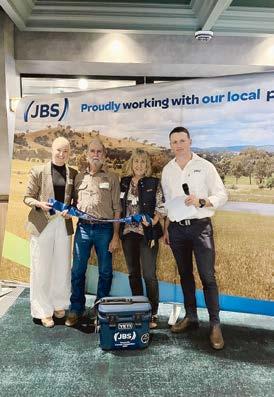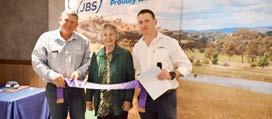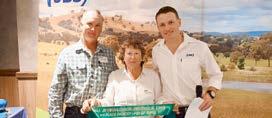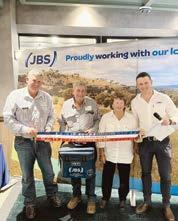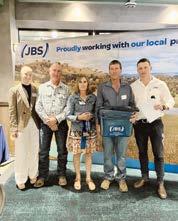


















Condamine sisters Claire and Hannah Morgan relied on the equestrian experience gained on their family farm Arubial to help them conquer the Mongol Derby, the world’s longest and toughest horse race.
On 7 August, both embarked on a 10-day ride, spending 12 hours a day in the saddle across 1000 kilometres of Mongolia’s vast, isolated wilderness.
“It was a once in a lifetime experience,“ said Claire, pictured left.
“Being able to travel while doing something in the realm of what we’ve grown up with here at home with horses and pushing ourselves to our personal limits - and doing it together - just added to the experience.
“We understood and appreciated that, no matter how prepared we were, it was going to be difficult. We were taken out of our comfort zones.
“But, it was such a cool thing that we are really grateful to have done.”
By Fiona Gowers
Mr McRobert’s association with Ekka spans 70 years, including 33 years as a Beef Week ring announcer.
“I’m a bit embarrassed by it actually because there are a lot of other people around the Exhibition who do so much,” Mr McRobert, 82, told Queensland Farmer Today.
“I just go out there, pick up a microphone and make a bit of noise.
“But, I am grateful for the honour, absolutely.
“I call the Exhibition my annual general meeting. I love the whole thing, the atmosphere and

catching up with a lot of people once a year.
“I love to go, getting out amongst the livestock and the people.
“I get to talk to farmers and find out how they’re going, how their seasons are going. The Bush, it’s a funny old place and there’s always plenty of news to share.”
Mr McRobert was born and bred in Oakey on the Darling Downs where his father managed the

butter factory and his mother worked for a stock and station agent.
At 16 he began work in the dispatch department for Australian Estates, firstly in Brisbane before he was transferred to Roma and around the south west. In 1963, he earned his auctioneer’s licence at 21 in Charleville then moved to Dalgety, then to Toogoolawah before selling at Cannon Hill alongside the well-known Stan Wallace.
Continued page 4




By Fiona Gowers
Address: 154-156 Haly Street
Kingaroy 4610
Telephone: 07 4182 0450
Website: QueenslandFarmerToday.com.au
CONTACT US
Editorial:
Email: newsdesk@QueenslandFarmerToday.com.au
Advertising:
Email: advertising@QueenslandFarmerToday.com.au
Classifieds:
Phone: 07 4182 0450 or 1300 666 808
Email: sales@networkclassifieds.com.au
EDITORIAL
Fiona Gowers Editor
E: fiona.gowers@QueenslandFarmerToday.com.au
Breanna Lloyd Journalist
E: breanna.lloyd@QueenslandFarmerToday.com.au
ADVERTISING
Samantha Wantling Sales & Marketing
E: samantha.wantling@WarwickStanthorpetoday.com.au
P: 0439 420 289
Jane Lowe Sales & Marketing
E: jane.lowe@QueenslandFarmerToday.com.au
P: 0408 488 609
Jemma Wilson Sales & Marketing
E: jemma.wilson@BurnettToday.com.au
P: 07 4182 0458
Nicola Rickuss Sales & Marketing
E: nicola.rickuss@TodayNewsGroup.com.au
Publisher: Damian Morgan
Managing Director: Daniel Pelcl. All material is copyright to
Queenslanders have won the two top awards at the cotton industry’s awards dinner at the biennial Australian Cotton Conference on the Gold Coast.
The 2024 Bayer Cotton Grower of the Year is Scott Balsillie, farm manager for Eastern Australia Agriculture in Dirranbandi while Steve and Bridget McVeigh from Dalby on the Darling Downs received the AgriRisk High Achiever award.
Scott’s family has been involved in cotton since his grandfather and uncles began growing cotton in the Miles/Chinchilla area in the 1980s.
Having worked full-time in cotton for 25 years, Scott now runs farms Clyde and Kio Ora, growing up to 6500 hectares of cotton combined.
He has been focused on improving water use efficiency through the bankless conversion from siphons, achieving huge benefits in labour and water savings, machine efficiencies and yield benefits.
He has moved from 800 metre row lengths to 1800, while employing deep tillage strategies, getting through the compaction layer to abouth 60 centimetres to allow the roots to be exposed to moisture and nutrients at depth.
Scott has also invested in the latest technology, allowing him to plant at 16kph achieving 250ha out of a 12-metre planter.
“I love growing cotton,” he said. “It’s an amazing crop to grow. It’s all the one percenters that you get right that give you the amazing crop at the end. There’s nothing better than seeing those rows of white gold.”
Steve and Bridget McVeigh run Loch Eaton near Dalby where they grow more than a 1000ha of irrigated and dryland cotton. Steve’s family has been involved in growing cotton for 44 years over three generations.
“I’m a big believer in development, diversification and technology,” he said.
“We are always looking at water and labor saving technologies and looking to adopt the latest tech. We monitor everything on the farm and we stop and start systems on the phone.
“We are big on safety and we have QR codes on all entrances, sheds and machinery where they can scan and get all policies and procedures.
“Anyone coming onto farm has to scan and sign in, so we know who is on farm at any time.”
Sharna Holman, meanwhile, received the CRDC Chris Lehmann Young Cotton Achiever of the Year award.
Sharna began her journey into the cotton industry in 2014 when she attended the Australian Cotton Conference as a student scholar.
Her current CRDC-supported PhD research focuses on the pest status of cluster caterpillar in northern Australia, addressing sustainable cotton production challenges.
The recipient of the Cotton Seed Distributors Researcher of the Year award is Dr Lisa Bird who plays a pivotal role in the management of the in-
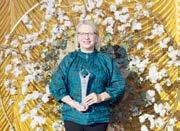
dustry’s insecticide resistance program.
The NSW DPI’s Australian Cotton Research Institute program conducts surveillance and research on insecticide resistance across five of the six major insect pests of cotton, including helicoverpa, mirids, thrips, mites and aphids.
Cotton Australia CEO Adam Kay congratulated all award recipients and all nominees.
“This year innovation, technology and sustainability outcomes feature prominently in the awards process,” he said.
“The award recipients have been recognised for their intelligent and forward-focused approach to growing cotton and that’s something all the nominees and the industry as a whole share.
“It’s also important to note that all nominees for Bayer Grower of the Year and AgriRisk High Achiever are myBMP certified and that’s an indication of how successful our best practices program has become.”
The prestigious Incitec Pivot Fertilisers Service to the Cotton Industry award was also announced at the dinner. This year that honour goes to Ross Munro from BMC Partnerships in Moree.
Ross began his relationship with cotton in the 1970s, working alongside his father.
They were establishing a business growing cotton and having conversations about starting a cotton transportation business.
Later he would become responsible for operating infield loaders, loading flat top trucks and transporting cotton modules on chainbeds.
Ross began pulling apart, redesigning and modifying these machines in the name of efficiency.
He travelled to America to develop a greater understanding of how the US was transporting cotton and conducting internal gin movements.
On returning to Australia, Ross met Danny and John Burke who were providing a similar offering in the market, they teamed up and formed what is known today as BMC partnership.
Those who know Ross well say that he always makes himself available, whether it’s about machinery setups, designing bale grabs or generally helping people to be more efficient at
and moving cotton.-
The Royal Queensland Show (Ekka) holds significant importance for farmers. For them, the annual event serves as a vital platform to showcase their agricultural achievements and innovations. For them, it is more than just a show; it’s an opportunity to highlight their hard work and share knowledge.
In August, more than 340,000 country and city residents came together over nine days to celebrate the agricultural community.
The Ekka this year boasted 1200 head of cattle in its beef cattle competitions and, according to The Royal National Agricultural and Industrial Association of Queensland (RNA), it hosted the largest showing of stud beef in the southern hemisphere.
The association said more than 20 breeds of beef cattle were displayed.
Furthermore, there was an incredible 742 entries in the junior cattle (beef and dairy) competitions in 2024 (up from 629 in 2023).
“It was great to see growth in our competitions with entry numbers up by 20 to 40 per cent in several of the 60 competitions, with more than 20,000 entries in total,” said RNA chief executive Brendan Christou.
“Our competitions showcase the very best of Queensland and visitors were amazed by award-winning entries and exhibitors in ... beef cattle, poultry and fleece breeds.”
The Ekka also plays a crucial role in connecting farmers with consumers. It provides a direct platform for farmers to engage with the public, raising awareness about the origins of their food and the importance of supporting local agriculture. Hopefully, this connection will help build consumer trust and encourages a greater appreciation for the agricultural sector.
In all, the Ekka is an essential event for farmers, offering recognition, education and consumer engagement. It strengthens the agricultural community and ensures the continued growth and success of farming in Queensland.
By Fiona Gowers
The threat of disease destroying Australia’s $4.2 billion cotton industry has prompted expert groups to unify to protect crops and support a burgeoning export market.
A $13 million partnership between the Cotton Research and Development Corporation (CRDC), University of Southern Queensland (UniSQ) and the Queensland government seeks to offer new strategies to help growers across Australia.
Fifth-generation cotton grower Mick Humphries, Moree, NSW, hopes a collaborative approach can unlock new solutions.
He said diseases typically cost his business about 20 per cent of his gross income annually.
“I want to claw that 20 per cent back, so I’m hopeful that bringing experts together in a strategic, coordinated way eases the burden for cotton growers into the future,” Mr Humphries said.
“Disease is a challenging area to get meaningful R&D (research and development) breakthroughs.
“We make headway on a promising solution and then, BAM! It’s back to the drawing board.
“Couple that with the piecemeal ‘one project here, one project there’ approach the industry has relied on for the past 30 years and it means new solutions aren’t coming fast enough.”
Australian cotton exports hit $4.2 billion in 2022-23 from $2.2 billion in 2021-22 as year-onyear volume figures surged nearly 70pc higher.
But, with this booming sector under constant threat of new diseases - and climate change threatening to increase the spread - CRDC is contributing its single biggest investment through the Australian Cotton Disease Collaboration (ACDC).
CRDC innovation broker Elsie Hudson said the ACDC, launched last month, hoped to cut the economic effect of current and emerging diseases from 14pc to less than five per cent by 2028.
She said the goal was to implement modern research and development methods to overhaul the approach taken to defend against diseases.
“Disease is a critical challenge for Australia’s cotton industry, contributing to significant yield losses, which undermine long-term confidence in growing cotton,” Ms Hudson said.
“In extreme cases, disease pressure is forcing some growers to opt out of cotton production.”
Research commissioned by the CRDC found disease was causing an eight per cent reduction in yield while those directly affected have lost 12pc on average and the more extreme cases have had 100pc of their crops wiped out.
“Their entire crop is at risk,” Ms Hudson said.
“While CRDC has invested in cotton disease research over several decades, the impact disease is having on growers’ profitability and productivity is increasing.
“A new approach is needed to overcome this persistent, leading limitation in the cotton production system.”
UniSQ Associate Professor Sambasivam Periyannan, director of the program, said the university’s Toowoomba campus in Queensland was uniquely positioned to lead the project.
“UniSQ is a renowned agricultural, researchintensive university, strategically located in Toowoomba on Queensland’s Darling Downs – a prime cotton-growing region.
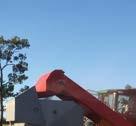
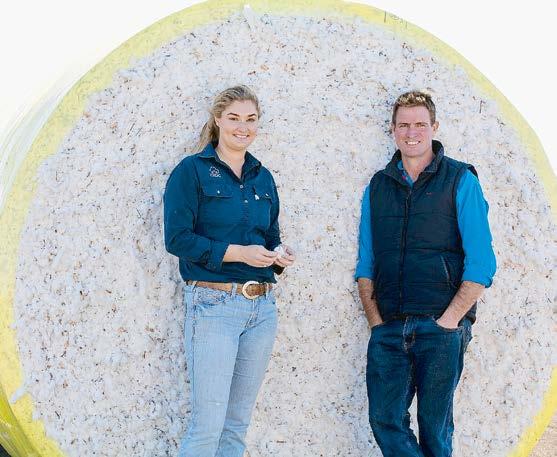
“This collaboration will enhance UniSQ’s research capabilities and bring significant benefits to CRDC, training next-generation researchers and consultants for the cotton industry.
“As a nationwide collaborative project, ACDC brings multiple experts from various agencies together to tackle disease in cotton.
Importantly, this project will look to extend beyond national borders, and collaborate with cotton researchers from leading cotton-producing countries overseas, namely, USA, India, China, Brazil and Pakistan.
“Through knowledge and material sharing, this global network will ensure the Australian cotton industry’s preparedness and contribution to the global cotton industry’s resilience against outbreaks of new strains of cotton pathogens.”
The Queensland government’s department of agriculture and fisheries will also contribute to the collaborative program.
The problem:
• Disease is causing an eight per cent reduction
in yield in the Australian cotton industry.
• For growers directly affected by disease, they are seeing an average reduction in yield of 12pc.
• In some extreme cases, it can be as high as 100pc: their entire crop is at risk.
• While CRDC has invested in cotton disease research over several decades, the impact disease is having on growers’ profitability and productivity is increasing.
The solution:
• A $13 million landmark partnership between the Cotton Research and Development Corporation (CRDC), the University of Southern Queensland (UniSQ) and the QLD Department of Agriculture and Fisheries (DAF) will help safeguard Australian cotton growers against the rising threat of disease and mitigate the economic impacts.
• CRDC is making its largest ever single investment in a first-of-its-kind collaborative approach to cotton disease research: the Australian Cotton Disease Collaboration (ACDC).
• ACDC changes the game for growers, delivering a comprehensive coordinated national disease program that will help understand the impact of disease, enhance foundational pathology resources and capability and deliver tactical management and innovative technical solutions.
• The goal is to reduce the economic impact of current and emerging diseases of cotton to less than five per cent of the cost of production –down from 14 per cent – by 2028 through practice change and research, development and extension (RD&E).
• ACDC is the first initiative announced under CRDC’s new five-year strategic RD&E Plan, Clever Cotton.
• ACDC embodies the industry’s bold, ambitious new approach to solving industry-defining challenges: a shift away from smaller projects to bigger investments with bigger outcomes and bigger impact.









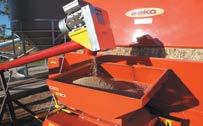
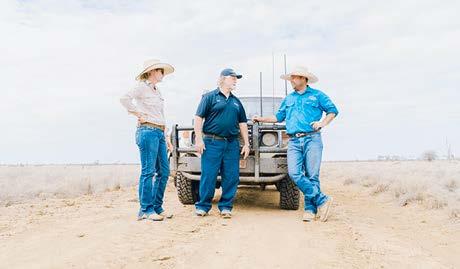
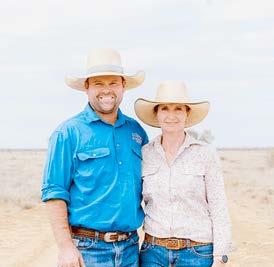
By Fiona Gowers
For almost 40 years, the Eggerling family has cultivated a farming legacy near Longreach, weathering Queensland’s challenging conditions and nurturing their sheep operation.
In 2021, Martin and Beck Eggerling bought “Wynn Downs” from Martin’s parents to start the second generation on the property.
“Martin’s parents were here for 38 years prior to that,” said Beck. “The opportunity came up and we grabbed it with both hands.”
Before the handover, Martin’s parents ran Merinos, which the Eggerlings initially kept alongside their Australian Whites flock.
However, finding it difficult to sustain both breeds, they sold the remaining Merinos 2.5 years ago and have since run about 7500 head of Australian Whites between two blocks.
“We run this line as we think they have great adaptability and do-ability to our country type,” Martin said. “They are hardy and a low maintenance breed.”
The Eggerling’s country comprises open boree
From page 1
Downs, which runs into gidgee country. It’s what they call “self-mulching black soil counter”. They have a good mix of creek and channel country throughout.
“In good seasons, we are able to double join to increase numbers quickly and achieve two lambings in 14 months,” Martin said. “This makes for a more regular income.
“Over the past few years, we have been breeding for numbers and carcase type.
“Once our core numbers were built, we concentrated on the confirmation, hair type and classing any colour out.”
The Eggerlings are “very flexible” as to where they sell their sheep.
“Depending on seasons and market at the time we will sell through sale yards down south (Wagga, Forbes and Dubbo), Auctions Plus and, also, we have been lucky enough to get the odd ‘on farm sale’.”
Navigating succession can be a daunting task for many farming families, but Martin says the assistance of QRIDA’s First Start Loan enabled them
to accelerate their plans and focus on creating a future for their children.
“The QRIDA First Start Loan, if we had never found it or applied for it, I don’t think we’d be where we are today,” he said. “It did fast-track us quite significantly.
“We’ve got three children of our own - two boys and one girl -and that’s something we’re certainly looking to do is set them up for their future as well.”
Local regional area manager for the Central Highlands and West Brad Whittington first met the Eggerlings at the Isisford Sheep and Wool Show.
He was able to share information with them about how the First Start Loan could be used as a financial stepping stone to assist with family succession.
“The QRIDA First Start Loan is a very good product to get young people into the primary production industry,” Brad said.
“I helped Beck and Marty understand how the livestock schedules and cashflows marry up with
what they’re predicting and how they work.”
Beck says Brad’s support was invaluable throughout their application journey.
“The help we had from Brad throughout the whole process was second to none, he was so approachable. When it came to the application there were no silly questions, he made it all make sense and he was wonderful.
“We advise people if they want to take that step, sit down with your regional area manager, have the chat, ask the questions.”
Brad encourages young producers to start the conversations and seek information on the financial support available such as First Start Loans.
“Doesn’t matter how small the question seems to you, ask the question and get an idea of where you can go with QRIDA’s products like our First Start Loans,” he says.
QRIDA’s First Start Loan, which offers up to $2 million in support, stands as a support beam for the next generation of producers, providing them with the financial stepping stone they need to make a start in agriculture.
is officially a legend - and he is only one of 18
“I’ve been around a bit!”
Mr McRobert’s first involvement with the Ekka was when he was 12, exhibiting dairy cattle.
But, it was during a break from his life as a stock and station agent and stud stock auctioneer in the mid-1980s that his role at the show became more formal.
While working in the Queensland office of the Australian Meat and Livestock Corporation (the forerunner to Meat and Livestock Australia), his boss suggested to the RNA they should take photos of the led steers to display on carcasses in the meat hall.
Mr McRobert took the photos before progressing to RNA stewarding and honorary council steward roles in the show’s beef competitions, particularly in the Santa Gertrudis ring.
He then settled into the role of announcing the Champion of Champions in Ekka Beef Week for 33 years.
And, since 2009, has led the Parades of Livestock around the ring in the main arena both at the conclusion of the beef cattle judging and during the Grand Parade on People’s Day.
He also donates his time as one of the leading auctioneers at the annual Stewards Charity Auction on Ekka Friday, raising funds for the Royal Children’s Hospital Foundation.
RNA president David Thomas announced Mr McRobert’s elevation to 2024 Ekka Legend at a reception at the Brisbane Showgrounds last month.
He said the award was bestowed on those who had made a remarkable contribution to the show.
“Keith McRobert has been an integral part of Ekka for an incredible 70-plus years,’’
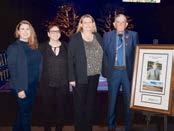
Keith McRobert with his daughters Courtney, Sloane and Libby. (Supplied)
Mr Thomas said.
“The voice of Ekka Beef Week has been a mainstay of the show’s Beef competitions.
“The Ekka’s Stud Beef and Led Steer Rings are highly regarded competitions and Keith McRobert has been instrumental in maintaining this excellence.”
Mr Thomas said Mr McRobert’s voice, which is synonymous with the Santa Gertrudis ring and Champion of Champions Judging, signals the arrival of Ekka each year.
“Not only has Keith run the beef competitions to the highest standard but he has mentored new stewards and given much of his time at philanthropic Ekka events,’’ Mr Thomas said.
“Remarkably Keith has barely missed one Ekka in almost 82 years – it is his cherished place where he connects with family and friends.
“We honour and thank Keith McRobert for his long term and invaluable contribution to the Royal Queensland Show over many years.”

By Breanna Lloyd
Yeppoon Show Society had the privilege of hosting the 2024 Central Queensland sub-chamber finals where this year’s Central Queensland SubChamber Showgirl and Rural Ambassador were crowned.
The awards kicked off on 29 June with onfarm tours of Harley Western’s Exotic Fruit Labyrinth and High Valley Dawn Permaculture farm where the finalists were individually interviewed by the judges.
The event concluded with the awards evening at the Beaches Restaurant, Rosslyn Bay where 19-year-old Emily Wickham, the Rockhampton Show Society representative, was crowned as the 2024 Central Queensland (CQ) Rural Ambassador Showgirl.
Born and bred on a cattle operation in Singleton New South Wales, Ms Wickham said she was inspired by the showgirls and their achievements from her hometown.
“I am also seeking my own personal growth and confidence within myself and spreading my passion of all things agricultural,” she said.
“I, 100 per cent recommend this position to anyone involved or interested in agriculture shows because it gives yourself such a powerful voice to use promoting the show, agriculture and fostering community connections.”
Now, with her new title in hand, Ms Wickham plans to visit as many Queensland agricultural shows as possible, helping promote youth in agriculture and act as a mentor and inspiration for young women across the nation.
Sarina Show Society representative Jessie Borg was the 2024 Runner Up CQ Showgirl.
“I am truly honoured to receive this title and I extend my heartfelt gratitude to my family for their unwavering support,” she said.
“I am also grateful to my fellow contestants, whose friendliness and camaraderie made the day extraordinarily enjoyable and memorable.
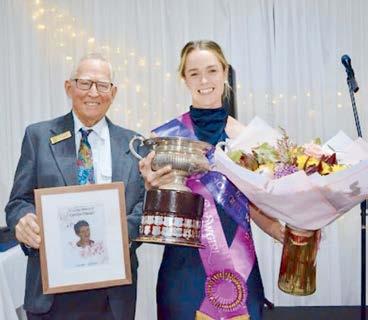
“I have forged lifelong friendships with many of you.”
This year’s CQ Rural Ambassador was awarded to Shikira Stehbens, who represented the Rockhampton Show Society and the runnerup went to Nathan Roots, who represented the Ridgelands Show Society.

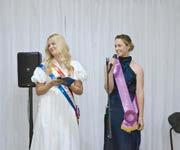
The 2023 Queensland Country Life Showgirl Isabella Hanson said it was a pleasure to share her journey of the past 12 months and get to know all of the contestants in the Showgirl and Rural Ambassador competitions.
“It was a pleasure to be a part of this event, share my journey of the past 12 months and get to know all of the contestants in the Showgirl and Rural Ambassador competitions,” she said.
“Congratulations to all who received awards and I look forward to seeing everyone continue on their Showgirl and Rural Ambassador journey.
“I would like to extend a massive thank you to Peter Curtis and Ken Landsberg whose upcoming absence from the Central Queensland show movement will be felt by many.”
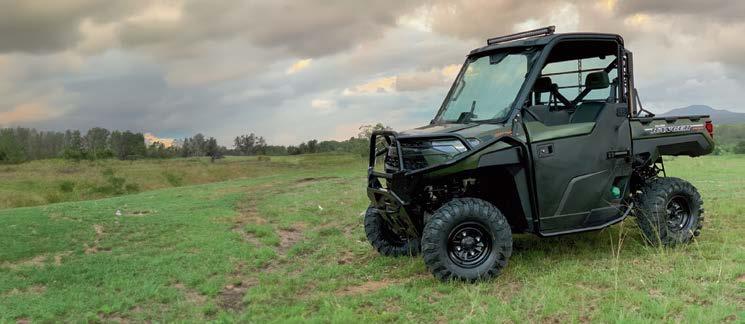
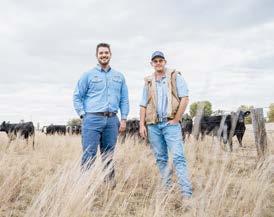

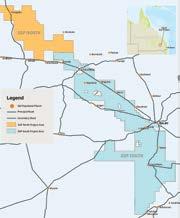
Arrow Energy has announced a major expansion of its 27-year Surat Gas Project (SGP) to an area north-east of Miles in Queensland’s Western Downs.
Known as SGP North, the development will bring more than 130 terajoules of additional gas to market per day for long-term contract and domestic customers.
The expansion is part of the SGP development, which will have the capability to produce more than 4000 petajoules of gas over the life of the project.
Construction on SGP North is scheduled to begin later this year, with infrastructure to include up to 450 new gas production wells, a new field compression station, 27km of pipeline, and road and infrastructure upgrades over two phases.
Arrow CEO Zhengxin Peng said he was pleased to receive sanction by its shareholders for SGP North, with first gas targeted for 2026.
“At a time when more gas is needed for homes, businesses and industries, the SGP North development will solidify Arrow’s position as a major producer of natural gas on the east coast,” Mr Peng said.
“Natural gas is an important part of the energy transition, and the expansion demonstrates the faith our shareholders have in our ability to manage and deliver large-scale projects.”
Mr Peng said the Miles region would benefit from up to 400 jobs to be created from the development.
“It means more jobs, more opportunities for local contractors and suppliers, including Indigenous businesses, and other economic benefits for the local community, including upgrades

to local roads.
“Like the first phase of the SGP, we will be minimising our environmental footprint and impact on the community through our agreement with Shell QGC, which enables us to use existing facilities and infrastructure.”
The SGP North development will include:
• Up to 450 production wells and associated gathering
• A 121 TJ/d four-compressor field compression station
• A 27km medium-pressure pipeline, connecting
the new field compression station to QGC’s Bellevue central processing plant
• Low-pressure gas connection to QGC’s McNulty field compression station
• Water and brine infrastructure expansion and upgrades
• Road and telecommunication upgrades.
About the Surat Gas Project
Located in Queensland’s Surat Basin, Arrow Energy has been safely, responsibly and reliably producing the natural gas required for a clean energy future since 2004.
The Surat Gas Project (SGP), underpinned by a 27-year gas sales agreement with Shell QGC, is expected to comprise up to 2500 gas wells and produce 4000 petajoules of gas.
Over the course of the project, we expect to create around 1000 jobs and are investing tens of millions of dollars each year in local road upgrades.
Every year, our social and community investment totals around $2 million as we partner with local communities to share the benefits of Arrow’s presence.
By Fiona Gowers
The inaugural chair of Eco-Markets Australia (EMA) Jo Sheppard has resigned after four years.
Her successor is Wilfred Finn who has been a member of the EMA Board for three years.
He will serve as interim chair until EMA’s AGM later this year and steps into the leadership role at a pivotal time as Eco-Markets Australia solidifies its position as a national leader in environmental markets.
During her tenure, Ms Sheppard played a pivotal role in transitioning EMA from its startup phase to becoming the first independent administrator of environmental markets in Australia.
She was instrumental in forming the inaugural Board and operational team, laying a strong foundation for the organisation’s future success.
Reflecting on her time with EMA, Ms Sheppard said: “I have worked in and around regional communities and agriculture most of my professional life and am a staunch advocate for the environment, regional communities and agriculture.
“Taking on the role as Chair at Eco-Markets Australia was a unique opportunity to champion the significant role farmers play in managing our landscapes.
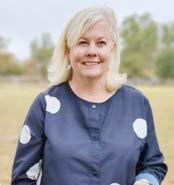
four years.
“My core belief is that we need to take a holistic approach to solve the environmental challenges we face – focussing on achieving meaningful environmental outcomes whilst also ensuring we build a strong future for regional communities and a profitable future for agriculture.

“Environmental markets have the ability to play an innovative role in achieving meaningful outcomes that will not only achieve the environmental outcomes we are seeking, but also support sustainable regional communities and a profitable future for farmers.”
Ms Sheppard added: “An independent environmental market administrator like Eco-Markets Australia is essential for providing transparency and integrity in governance, which instils confidence in investors and market participants.
“I extend my thanks to the inaugural Board,
the EMA team, original foundation members and key stakeholders for their dedication and hard work.
“I am excited to see the continued progress of Australia’s first environmental administrator.”
Ms Sheppard will continue her advocacy for regional communities and agriculture through her continued role as CEO of Queensland Farmers’ Federation, as well as her recent appointment to the Queensland Energy System Advisory Board (QESAB).
During Ms Sheppard’s tenure, Eco-Markets Australia was structured as a not-for-profit ACNC-registered charity, upholding the core principles of maintaining global best practices in the environmental markets it administers through integrity, governance and transparency.
One of the significant achievements under Ms Sheppard’s leadership was the administration of the Reef Credit Scheme, Australia’s first voluntary water quality market.
The program incentivises farmers and landholders to implement land management practices that enhance the water quality of the Great Barrier Reef catchment.
To date, more than 50,000 Reef Credits have been generated, which represents more than 50 tonnes of Dissolved Inorganic Nitrogen (DIN) prevented from entering the Great Barrier Reef.
Researchers from the University of Southern Queensland (UniSQ) are taking the idea of “try before you buy” straight to the bank to make it easier for farmers to utilise ag tech.
The $3.7 million research project – a collaboration between UniSQ, the Southern Queensland and Northern New South Wales (SQNNSW) Innovation Hub, the Grains Research and Development Corporation (GRDC) and Queensland Cropping Initiative – investigates how to better use existing and emerging ag technologies to improve drought resilience for grain farmers.
UniSQ School of Agriculture and Environmental Science lecturers Michael Scobie and Justine Baillie are leading the Changing the Game – Resilience to Seasonal Variation and Drought through Ag Tech research, which aims to validate commercially available ag tech at a full farm scale rather than small experimental plots.
“There are so many technologies out there, but a lot of farmers are a bit confused about how to best use them,” Mr Scobie said.
“We’re looking at agricultural technology and adoption with a drought mitigation focus. We’re not trying to invent any new technology; everything we’re trialling is something a farmer can go into the shop and buy today or, at least, very soon.”
Justine Baillie said this research was trialling both software and hardware in the ag tech arena – an area that is rapidly changing and developing.
“This is a really broad area where there’s a need for continuous engagement and testing for the demonstration of what’s possible,” Ms Baillie said.
“These technologies aren’t exactly plug and play – we’re unpacking the challenges that exist there so that we can learn from them and the farmers can use that knowledge.
“We are smoothing the on-ramp for industry and shortening the pathway to adoption.”
GRDC grower relations manager (north) Rebecca Raymond said the project was developed


to ensure grain growers had the latest digital tools and technology to help them prepare and adapt for droughts.
“This project was very much driven by industry, with growers keen to understand how data management, artificial intelligence and smart
machinery could help improve practices on-farm to maximise rainfall efficiency, inform planting decisions and optimise crop inputs and other costs,” Mrs Raymond said.
“Using commercial demonstrations as a key part of this project, we wanted to ensure growers and agronomists could see the practical feasibility






the heart of the RENN Roller Mill has been its precision-machined 16” diameter rolls, which provide more
area per revolution compared to other brands of roller mills with smaller diameter rolls.
and money year after year





The Toowoomba region has maintained its standing as the best performing agricultural region in Queensland with a Gross Value of Production (GVP) worth $1.27 billion in 2023-24.
The figure also boosts the value of Queensland’s agricultural sector to its second highest ever valuation of $23.56 billion.
The Western Downs ($951M) and Bundaberg ($899M) round out the top three regions across the state.
Toowoomba region mayor Geoff McDonald said despite economic growth and diversification of the region’s economy over recent years, the agriculture industry today remains a major generator of economic value and jobs.
“About one in 20 jobs in the region are linked to agricultural production,” Mayor McDonald said.
“Agriculture also has major flow-on impacts onto the rest of the Toowoomba region’s economy, supporting jobs through supply chain linkages.
“Despite many challenges facing the sector including drier conditions and higher input costs our agriculture industries continue to be a major contributor to the region’s economic growth.
“The sector continues to lead on on-farm best practice and advancements in technology, while also navigating the opportunities and challenges presented by the renewable energy roll-out and associated land use planning considerations.
“This result is also a timely reminder of the critical importance of strategically protecting agriculture land for future generations so that we can all continue to enjoy the financial benefits for years to come.”
The $1.27 billion is underpinned by diverse

agricultural products across the region including egg production, cattle, cotton, horticulture, poultry and cereal crops such as sorghum, barley and wheat.
The latest valuation was based on new AgTrends figures released by the Queensland Government’s Department of Agriculture and Fisheries.
The total value of Queensland’s primary industry commodities is forecasted to be valued at 23.56 billion, an increase of 6.59 per cent from the previous year and an increase of 3.44pc on the average of the last five financial years.
Highest GVP in 2023-24 by LGA ($):
• Toowoomba $1.27 billion
• Western Downs $951 million
• Bundaberg $899 million
• Burdekin $735 million
• Cassowary Coast $727 million
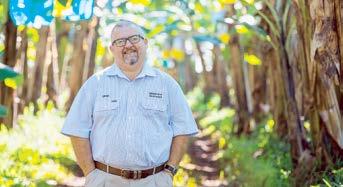
By Sam Spina, QRIDA regional area manager for Far North
It’s been almost a decade since the first case of Panama disease tropical race 4 (Panama TR4) was detected in Far North Queensland, and still this incurable and insidious disease poses a serious threat to our valuable banana industry.
At least eight cases of Panama TR4 have been confirmed on banana farms in the Far North since the soil-borne fungal disease was confirmed near Tully in 2015.
We know Panama TR4 is easily spread through people, vehicles, machinery and animals and can survive in soil for decades, destroying banana plantations and jeopardising the livelihoods of growers.
When it comes to Panama TR4, don’t slip
on banana biosecurity. Make strict biosecurity measures a priority for your farm now to save your operation from the devastating impacts of this disease later.
QRIDA’s Sustainability Loans can help Queensland banana growers improve the biosecurity of their farm through a range of measures including purchasing or upgrading washdown facilities, erecting exclusion fencing or installing decontamination stations. Our concessional Sustainability Loans can also help banana growers improve the resilience of their farm by diversifying into new agricultural markets, expanding their operation, preparing for disasters and more.
If you are interested in improving the biosecurity or sustainability of your banana farm, please visit qrida.qld.gov.au to find out more information about our financial assistance.
By Matthew Pearce
Livestock transport Industry stakeholders attended a roundtable discussion on Friday, 16 August, to discuss extending operating hours for road trains travelling through Rockhampton.
The Livestock and Rural Transporters Association of Queensland (LRTAQ) hosted the Rockhampton Road Train Roundtable at the CQLX Saleyards.


Paul




Central Queensland delegate Athol Carter said the LRTAQ had been lobbying for seven years for better access for their high productivity type one road trains to the two red meat processing facilities on the northside of Rockhampton, operated by Teys Bros and JBS. Current access is from 7pm to 7am, but the LRTAQ wants to extend this to 10am to 3pm and 5pm to 5am, as well reducing the requirement for operators to need three permits per year to travel to the two abattoirs.
The existing route through town - around Stockland and down Musgrave St - would remain the same.
“This will improve productivity, driver fatigue, maintenance and take heavy vehicle traffic out of the CBD of Rockhampton,” Mr Carter said.
Despite the current hours being from 7pm to 7am, Mr Carter said deadlines meant many road train drivers needed to stop at the CQLX breakdown paid during the day, splitting their trailers and making two trips into the abattoirs.
He said the association was not looking for 24-hour access, with the revised times taking account of peak traffic times and school hours.
“Rockhampton may be the beef capital, but there is a massive disconnect, with other operators running road trains up and down the Bruce Highway, from Brisbane to Cairns, unrestricted,” he said.
“We are an industry that supports industries, delivering to two processing facilities here that deliver to the world and employ 14,000 people locally combined.
“Every business in Australia is struggling with labour; We need to get smarter and make sure of the efficiency of these high productivity vehicles and do more with less.
“Let’stakeasensibleapproachtothisandwork togethertofinda solutionthatworksforeveryone.” AgForce Central Queensland president John Bak-
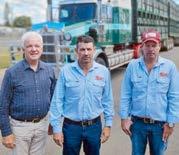
er said the revised hours would improve animal welfare as cattle would no longer be left at CQLX for hours while operators decoupled their trailers to a “double run”.
He said the changed hours would cut road train movements by half, as well as allowing drivers to load cattle in the morning and be home at a “reasonable time” in the afternoon.
“It would certainly make life a lot easier for a lot of people,” he said. Queensland Trucking Association chief executive officer Gary Mahon said his organisation had a strong interest in safer road train operations and felt current technology meant the trucks were safer than ever.
“We can currently run b-triples through Melbourne to the port of Melbourne,” he said.
“This is the beef capital, why would you not be moving with the times?
“This equipment is unsurpassed anywhere in the world.
“It is well established that the equipment can handle the roads and infrastructure as well as access and mobility issues that arise
“These sorts of combinations are vast improvements on equipment from 15, even 10 years ago.”
By Breanna Lloyd
Thirty-one years of outstanding Limousin genetics will be on display at Talana Limousins’ annual bull sale at the Emerald Ag-Grow sale complex on Thursday, 19 September.
All 30 bulls on offer are JBAS-7, performancerecorded, genetically-docile and easy to finish.
Since 1993, Talana Limousins has sought to produce better-suited cattle to Queensland conditions and has steadily adapted them to the local environment markets.
Stud founder Gary Graham said they started with the best females they could find.
“We flushed and AI’d them for many years,” he said.
“Although those were wonderful cows at the time, and we received many accolades and sold many high-priced stock from them, our herd has progressed so far that if any of those originals were born today they would be culled in the weaner pen.”
Throughout the years of Talana, the Grahams changed the type of Limousin cattle to determine what was best suited.
Any problems the Grahams faced were dealt with ‘head-on’, the majority being docility and cover/finish.
Furthermore, they wanted to improve their herd’s fertility and milk production.
Gary and his son Anthony were so successful with their research, that they were able to support the use of their genetics for first cross and second cross commercial females.
Using performance recording, Gary and Anthony determine their herd’s breeding decisions by the traits they portray.
“We have seen so many examples of herds that make their breeding decisions almost solely on the traits they are able to measure to the neglect of others that are not recorded and the animals become impractical in one way or another,” Gary said.

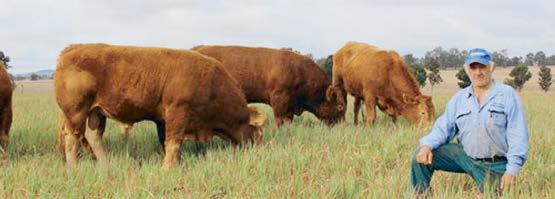
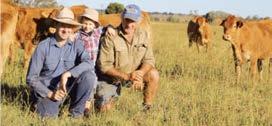
“EBVs are an indicator - not the result - and are but a small, but important, subset of what makes a good animal.”
No matter what, Gary and Anthony have made it clear they only want reliable, predictable performance in all traits of a beast.
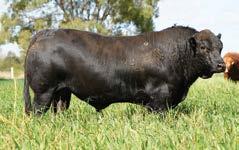
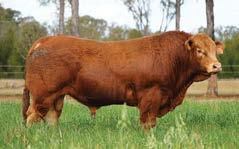

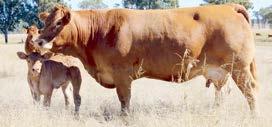
Talana’s female base is grown on grass and joined to calve at around 24 months.
Their females are expected to rejoin on time, raise a heavy calf and repeat annually.
“They have a strong early growth rate and influence the type of bulls we produce,” Anthony said.
“They have strong early growth with early- to mid-maturity with large scrotal, calving ease and ease of fleshing and finish.
“We know Talana Limousin bulls will work well in Central and North Queensland conditions, well, they already do.”
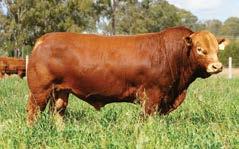

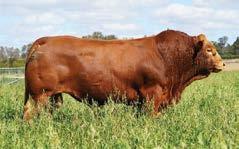
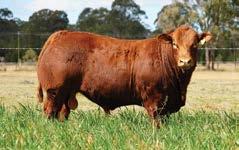

In the fast-paced world of machinery and vehicles, finding a company that remains true to its roots while continually evolving to meet customer needs is rare.
Black Truck and Ag, a family-owned and operated business, exemplifies this balance.
With deep ties to the communities it serves, the company has grown from a single branch to multiple locations across Queensland and New South Wales, all while maintaining its commitment to providing exceptional service and a wide range of products.
Founded on the principles of trust, reliability, and customer-first service, Black Truck and Ag has become a cornerstone in the communities it serves.
The company’s philosophy, “Customers for Life,” is not just a slogan but a guiding principle that has shaped its operations since day one.
This philosophy emphasises the mutual respect and benefits that should exist between a business and its customers, ensuring that every interaction leads to a lasting relationship.
Managing Director Jason Black, who runs the company from its Toowoomba headquarters, is a key figure in maintaining this philosophy.
His leadership ensures that the company stays true to its values while embracing the changes necessary for growth.
Jason is deeply involved in the day-to-day operations, frequently visiting branches and working closely with managers to uphold the high standards of service that Black Truck and Ag is known for.
One of the most significant aspects of Black Truck and Ag’s growth is its continued expansion. As the company welcomes more manufacturers into its fold, it is better positioned to meet the diverse needs of its customers.
Whether you’re in the market for a car, truck, work van, mower, header, or cultivator, Black Truck and Ag has you covered.
The company’s product line-up includes some
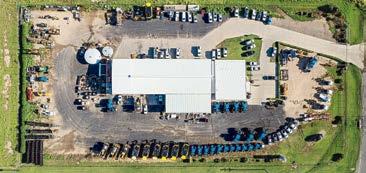
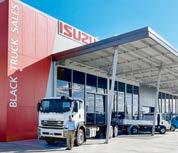
of the most respected domestic and international brands in the industry, such as Fendt, Massey Ferguson, Kubota, Isuzu Truck, Isuzu Ute, Ram, Landini and Simplicity.
This expansion is not just about adding more products; it’s about providing comprehensive support to customers no matter where they are.
The “Black Truck and Ag Road” is more than just a concept – it’s a reality for many customers who rely on the company for all their machinery and vehicle needs.
With branches in Gatton, Toowoomba, Dalby, Roma, Chinchilla, Goondiwindi and Moree.
Black Truck and Ag has created a network that allows customers to the security that they will receive the same high level of service and support at every from manufacturers such as Isuzu Truck, Isuzu Ute, Kubota, and more along the way.
As Black Truck and Ag continues to grow, so does its service departments. Recognising the importance of keeping machinery and vehicles in top condition, the company has invested heavily in its service offerings. New leadership in the service departments at Dalby, Roma, and Chinchilla has brought fresh perspectives and a renewed focus on excellence.
This, combined with specialised training from
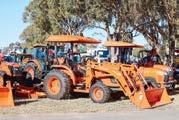
its manufacturers, ensures that Black Truck and Ag’s service technicians are among the best in the business.
Whether you are a farmer in need of reliable service, a business owner looking for commercial vehicles, or a family who needs a new Ute, Black Truck and Ag is there to help you every step of the way.
As Black Truck and Ag continues to expand and evolve, one thing remains constant: its commitment to its customers.
Jason Black’s leadership, combined with the dedication of the entire team, ensures that the company will continue to thrive and serve its communities for years to come.
In a world where businesses come and go, Black Truck and Ag stands out as a company that values tradition while embracing progress.
With a wide range of products, exceptional service, and a commitment to customer satisfaction, it’s no wonder that so many people choose Black Truck and Ag for all their machinery and vehicle needs.
Whether you’re a long-time customer or new to the Black Truck and Ag family, you can be sure that you’re in good hands.


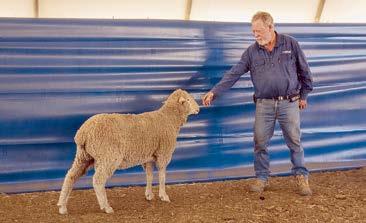

By Breanna Lloyd
A “next generation” Merino stud, Karbullah Poll Merinos is eagerly preparing for its on-farm ram sale in September with its own “personal touch”.
All are invited to attend their open day on Friday, 6 September and the sale day on Monday, 16 September.
John Kennedy, commercial sheep and cattle operator at Uralla, New England, NSW says: “In terms of doability, ease of shearing, worm tolerance, fertility and big cuts of quality white wool, they have ticked all of the boxes.
“I am always keen to buy Karbullah blood sheep, they have done exceptionally well here.
“They are big, clean bodied sheep cutting a good, long white staple wool that can handle heavy rainfall.
“I’ve noticed their ewes are very fertile and are excellent mothers.
“At the end of the day, the Karbullah bloodline makes a very generous return on invested capital.”
Mark and Vicki Murphy established the dual-purpose Merino stud in 2001, situated 70km north of Goondiwindi.
About 1100 stud and commercial ewes and 300 rams are produced on Karbullah, an 8000 acres Brigalow and Belah property, for their annual sale.
The pair primarily focus on producing Merino with high productivity traits with superior wool and unique carcass characteristics, strong fertility and survival instincts.
A proud yet subtle trait of their Merino flock is that their ewes have not been chemical drenched as a mob since 1992, nor mulesed since 2004.
“Our goal for the past 25 years has been to breed a dual-purpose Merino with attributes that make them productive and money makers whilst
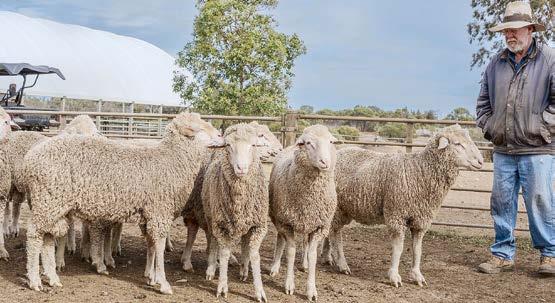
being a “green” sheep,” Vicki said.
“We have many other traits which are reaping clients rewards, as well as the actions happening in the paddock.”
Also, the Murphys have sold their sheep meat products to butcher shops for six years, gaining valuable carcass information for the package of
dual purpose Merinos.
Once their stud was registered in 2001, Mark and Vicki were exposed to cutting-edge genetics from fellow SRS studs through the guidance of Dr Jim Watts. Since his passing, a group of breeders have continued to combine their values and kindship.
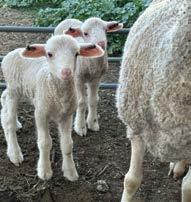
The journey enabled Mark and Vicki to benchmark, push genetic gains and increase accuracy, along with SRS studs and clients to produce the “Next Generation” Merino.
Mr Kennedy, Uralla, concluded: “From the thousands of sheep traded, Karbullah sheep have been the best of them.”

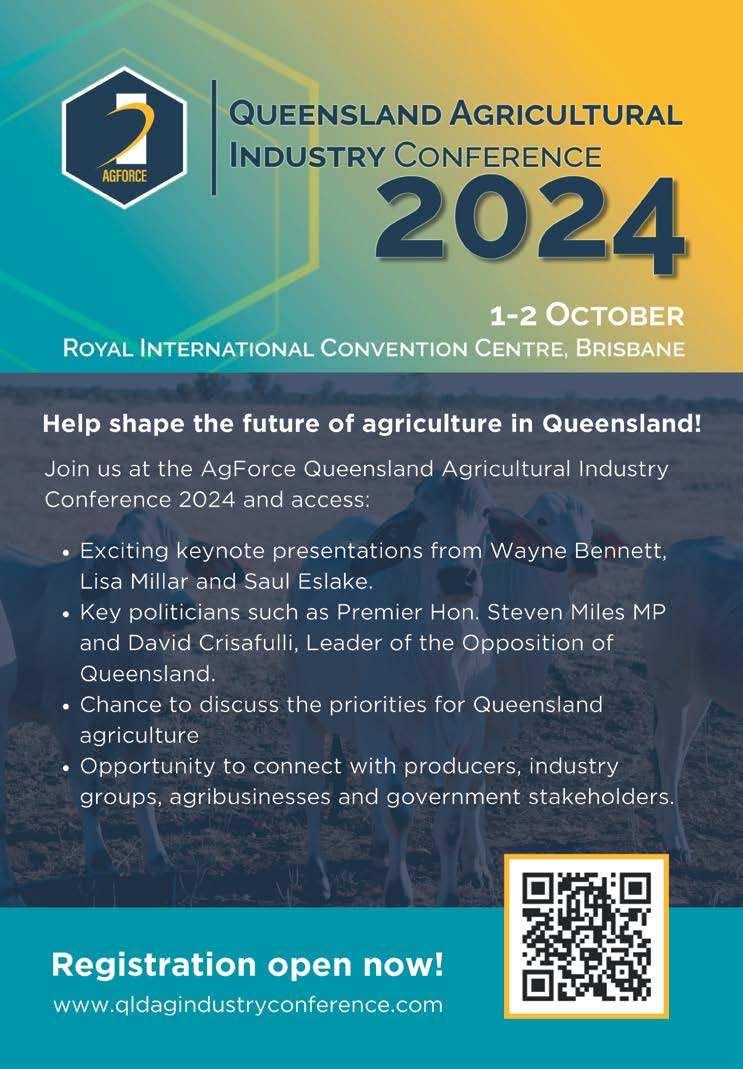
The versatility of Bellevue genetics has once again shone through at the 2024 Ekka Prime Lamb Carcase and Paddock to Plate Competition, with ribbons won in all classes entered.
“We put a lot of time, effort and data collection into our Dorper genetics and we are thrilled to see that our prime lambs keep coming out on top, ground truthing our rams and our stud breeding program,” said David Curtis.
Bellevue is thrilled to have taken out the overall Paddock to Plate Competition for the second year in a row. These champion pasture-fed lambs were a pen of three White Dorper lambs, with an IMF of 5.55 per cent. They weighed 51kg hot on the scales, before being processed the following day and dressing out at 26kg.
They were raised exclusively on organic pasture on our Bellevue property.
Bellevue 2024 EKKA results:
Prime Lambs carcase competition:
• Champion, Grass-Fed Single Lamb
• Overall Reserve Champion, Pen of Three Lambs
• First, Pen of Three Restaurant Trade Lambs
• Second, Pen of Three Light Trade Lambs
• Second and Third, Pen of Three Heavy Trade Lambs Paddock to Plate Competition
• Overall Paddock to Plate Champion
• First & Third, Paddock to Plate, Pasture-Fed, 22-34kg
• Second, Tasteoff Challenge
• Carcase Champion
This is an industry-relevant event, with more than 40 entries over a number of sheep breeds.
A huge thank you must go to the competition sponsors: Carey Bros Abattoir, Rob Ashton’s Butchery, Millmerran Abattoir, McMahon Brothers, Meat and Livestock Australia, Riverina Stockfeeds, as well as Stocklive.
Chief steward Peter Hood and his many volunteers and officials so generously give their time, year after year, organising this industryrelevant event.
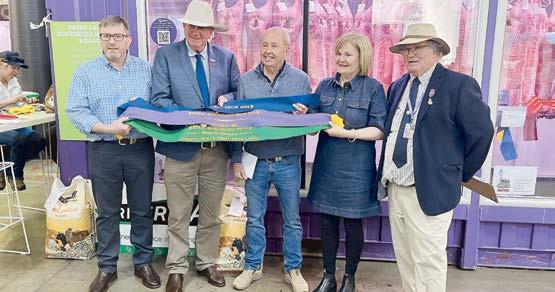
Whether you are a stud or commercial breeder, this competition’s feedback is invaluable; being able to see what an ideal, trade-suitable carcase looks like.
For Bellevue, this success demonstrates that the Bellevue stud breeding objectives remain “on point”, with selection focussing on the important attributes that align with producing a consistent quality, trade-desired prime lamb carcase.
Bellevue Dorper lamb is supplied to Brisbane
butcher, Meat at Billy’s with retail outlets at Ashgrove, Paddington and online, as well as Sunshine Coast butcher, Eumundi Meats at Noosaville.
Every Bellevue ram sold is a product of a breeding program that places maximum emphasis on measuring (LambPlan) and selecting for the commercial production of prime lamb.
Early maturity and weight gain, exceptional and high yielding carcasses, enough fat for excellent eating quality and maternal traits, visual
selection for structural correctness, quality, temperament and soundness.
• Bellevue will offer 120 rams at their 23rd Dorper and White Dorper Ram sale, to be held on Thursday, 26 September, on-property at Bellevue, Millmerran.
• The auction will be conducted by Nutrien and interfaced with AuctionsPlus.
• Register for sale updates by clicking the link at www.bellevuedorpers.com.au
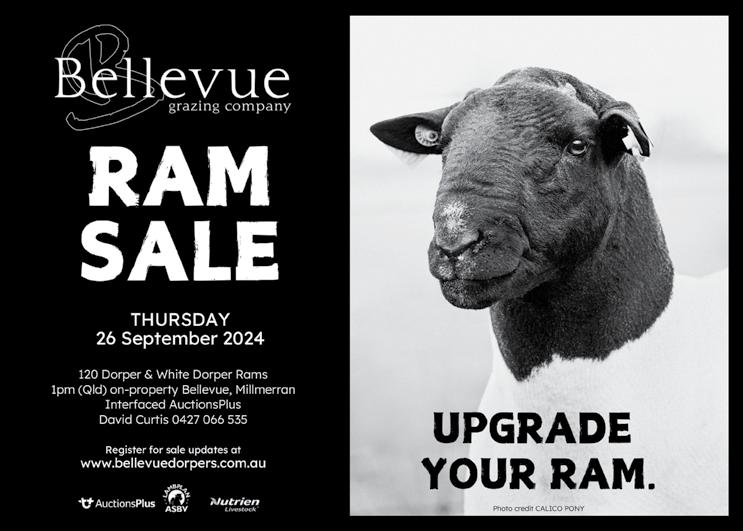
Twenty-one certified Charbray breeders will showcase their top-line genetics with a select offering of 93 bulls at the Charbray Society’s 47th Annual National Bull Sale to be held at CQLX on Monday, 30 September.
“Buyers won’t be disappointed, if you are looking for quality Charbray bulls, whether you’re a stud or commercial operation, you will be rewarded,” said Trevor Ford, National Charbray Sale committee chairman.
Charbray Seed Stock, with depth of breeding, produce predictability and consistency, which is the must-have ingredient in any profitable operation. The breed’s popularity is quickly growing as a no-nonsense, affordable addition to a broad range of breeding programs.
Having the reputation as an all-round paddock performer, they step up and improve your bottom line.
Easy-doing cattle that finish quickly and can withstand a harsher environment. A breed that really does tick all the boxes.
Charbray Society president Glen Zeimer said: “Charbrays’ stats in the saleyards, selling rings and an ever-expanding herd book, proves confidence in the breed’s performance.”
The on-line catalogue is available now for viewing at www.charbray.org or register for your hard copy at admin@charbray.org
Buyers heading to CQLX for the Monday sale are invited to view the offering on the Sunday afternoon, followed by the popular “meet and greet” at CQLX downstairs beside the selling ring from 5.30pm.
The evening will include a feature female sale, “Pick of the Pen” live auction, with five heifers on offer by certified breeders Roper Downs, Tarome and Dellyvon Studs.
Vendors and agents (Elders) are kindly donating all commission raised towards the staging of the 2025 Young Beef Breeders’ Bash.
The fifth annual Elite Heifer lucky number draw with also take place, with this year’s prize elite heifer donated by certified Charbray breeders Tarome Charbrays. Numbers in the draw are $40 each or three for $100 with 150 numbers available.
Lucky numbers are available by emailing admin@charbray.org
Online bidding will operate through the Stocklive platform at www.stocklive.com.au
Attending agents are Elders and GDL.





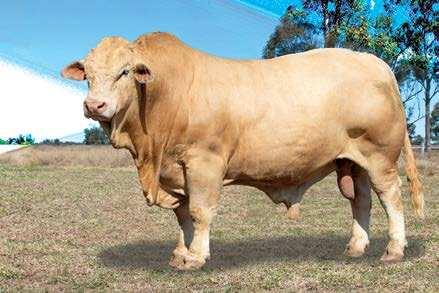

Beef producers looking for quality bulls to improve their herd’s performance will be treated to almost daily Santa Gertrudis sales during September-October throughout southern, western and central Queensland.
The Santa Gertrudis breed, which has been exerting its considerable influence on Australian beef for almost 75 years, is experiencing resurgent interest from multiple supply chain partners for its attractive weight for age, fertility, carcase quality, feed efficiency, longevity and quiet temperament.
Santa Gertrudis Breeders Association of Australia director, breeder and stock agent Neil Watson of Tamworth, NSW said using Santa genetics gave producers options, regardless of where they operated or the markets they were targeting.
“Santa Gertrudis is one of the most versatile breeds of cattle – they can be crossed with any other breed for a profitable result,” Mr Watson said.
“They can be joined to Hereford, Angus, Charolais, Shorthorn and Brahman, positively changing the outcome of the progeny not only in weight for age and Meat Standards Australia (MSA) compliance but also importantly sustainability.”
Inherently resilient, Santa Gertrudis is one of the few breeds genetically suited to all climatic conditions.
A slick coat, foraging ability and ability to travel long distances to food and water ticks the boxes for sustainable production and a low carbon footprint.
As the beef industry progresses its aims to be carbon neutral by 2030, with grazing management key to reaching the goal, Mr Watson said Santa Gertrudis cattle were perfectly positioned to offer producers an accessible and affordable sustainability solution.
He said when it came to grass-fed production, Santa Gertrudis excelled with above-average daily gain and early maturity for the yearling grassfed beef market.
While the breed also has the flexibility to meet
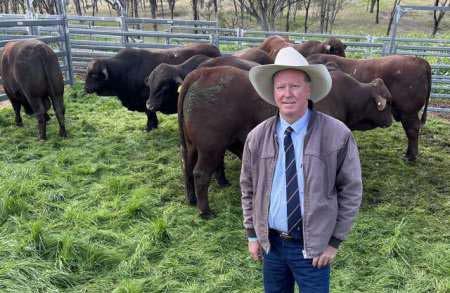
specifications for the bullock or heavy grass-fed markets with high red meat yield and eye muscle area and adequate fat.
“Grass-fed is our key market as the cattle can do it naturally – Santa and Santa-cross cattle have
theabilitytoputonweightwithadequatefatcover off grass in environments ranging from northern and central Queensland to Victoria,” Mr Watson said.
He said the breed’s superior average daily
gains, feed efficiency, heat tolerance, docility, and immune competence resulted in strong demand from lot feeders for domestic and export programs.
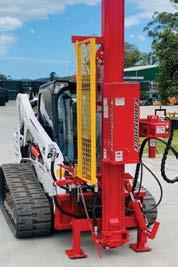
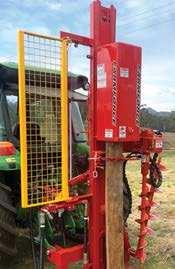


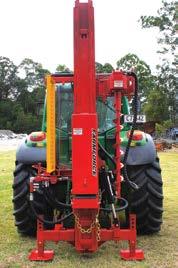

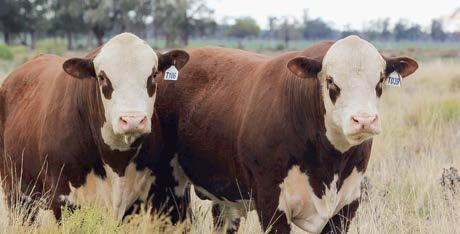
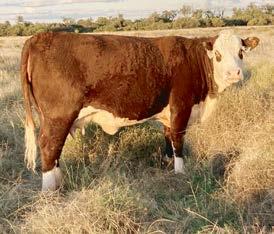
By Breanna Lloyd
Get your bidding cards ready for the annual Binara Poll Hereford online bull sale commencing on Thursday 12 September.
The two-day sale, concluding on Friday 13 September, offers 24 lots of Binara’s polled Hereford bulls that have been vaccinated and semen tested.
The scanning results for the sale bulls averaged 824kg in weight, P8 fat depth, rib 8.8, 130 EMA, 5.9 IMF and 40.3cm scrotal.
On-property inspections and the catalogue are allowed upon request.
Running the stud along with a farming operation, Ivan and Amanda Burcher said they strive to produce bulls that have a commercially accept-
able phenotype.
“Our bulls have the genetics to boost anyone’s herd in profitability and pigmentation while maintaining their sleek hair and soft skin type,”
Amanda said.
“This draft of bulls has sires to suit differing markets.”
Return buyers Darren and Alice Marks of Winvic Pastoral have had numerous breeding successes thanks to Binara bloodlines.
“Darren and Alice have been our clients for a very long time,” Amanda said.
“These are the first ‘B’ classified bulls to sell in Australia at the national sale.”
Where it all began
The family stud back then called Kalem Poll Herefords was established in 1973 by Trevor and
Pearl Saal.
At 96-years young, Trevor remains very interested in the Poll Hereford breed and, according to Amanda and Ivan, is always keen to hear what they are up to.
Originally, the stud resided on Arcadia Valley with 180 females and bulls from Roma Poll Herefords.
In 2012, Ivan and Amanda established Binara Poll Herefords and forged it with Kalem Herefords.
During the Covid-19 outbreak in 2020, Ivan and Amanda decided to discontinue selling their bulls at the Roma sale and began selling them at their annual online sale.
For numerous years, Kalem and Binara Poll Herefords have had great success at the Ekka,
state and national shows while supporting Hereford Youth.
This year marks the stud’s 20th year with supporting Downlands College.
Now residing on Binara, Pittsworth, the stud and commercial herds are run with the same conditions.
Currently, Ivan and Amanda run 150 stud females with 45 heifers to be joined at the end of this year. They run 110 females in their commercial herd.
“Like any stud business, we believe profitability is front and centre, along with high fertility, soundness and do-ability is a must for all females in our herd,” Amanda said.


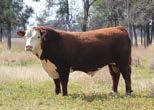
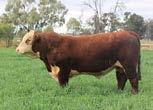
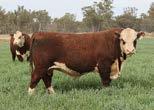
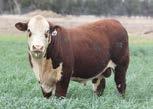
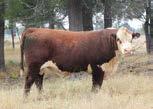
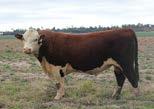


By Fiona Gowers
“Very proud” is how Jim Wedge describes his thoughts about this year’s line-up of Ascot bulls and heifers to be sold this month.
The 2024 All Polled Ascot Spring bull sale is on Friday, 20 September at 12 midday at “North Toolburra”, Warwick.
“We are very proud of this year’s line-up of bulls and heifers,” Mr Wedge said.
“They display the balance we are breeding for with docility, structural correctness, good weight for age, MSA-focussed carcass traits, fertility and polledness.
“All bulls and heifers are born and raised onproperty in Queensland and are suitable to settle anywhere, including WA.”
Mr Wedge and his wife Jackie head into their 17th sale brimming with confidence. Last month, Ascot Cattle Company was identified as a “Top Stud” in Bush Agribusiness’s Top Stud’s 2024 publication.
“This recognises that our genetics, expressed through the maternal Breedplan indices, are in the top half of the breed,” Mr Wedge said.
“Across all studs in Australia, only 237 studs made the list.”
ANGUS SALE BULLS
The 2024 All Polled Ascot Spring bull sale comprises 77 Angus bulls: 55 x two-year-olds and 22 x 17 to 18-month-olds. All are by breed-leading AI sires including: MM Paratrooper, Dunoon Prime Minister, MM Rocketman, Texas Iceman, MM Rembrandt, Ascot Revolution, Lawsons Rocky, Sprys General and Moe.
CHAROLAIS SALE BULLS
In all, 67 polled Charolais bulls will be offered: 46 x two-year-olds and 21 x 16- to 18-month-olds. There are 45 DNA-tested homozygous polled bulls in the sale including: First bulls by Ascot Rockstar, Ascot Recharge, Ascot Regent. Other sires represented are Rosedale Lump Sum, Rosedale Quantum Leap, Silverstream Padra, Paringa Kilo Packer and Silver StreamManhattan.

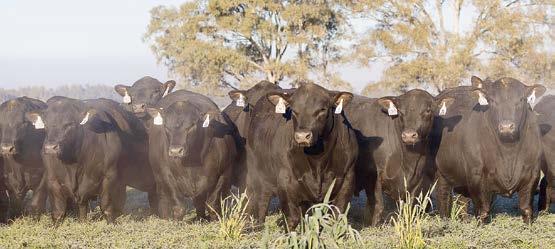
“We are also selling the first son sold in Australia of $100,000 bull Palgrove Rockafella. He will be about 13 months at sale time,” Mr Wedge said.
“We are very proud to present the best and largest line up of stud, registered heifers in both breeds we have ever put up for sale.
“All are polled. The 61 heifers are from the heart of the herd and only sold to keep our numbers to a serviceable level.”
Other sale highlights:
• 31 x ANGUS HEIFERS with breed-leading sires: Prime Minister, MM Paratrooper, MMRocketman,MMRembrandt,AscotRevolution,Lawsons Rocky, Landfall New Ground, Sprys General and first daughters by the NZ sire Stokman Solution.
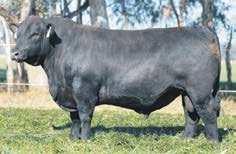
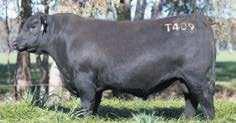
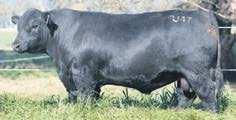
• 30 x polled CHAROLAIS HEIFERS. Sires represented include: Palgrove Rockafella, Ascot Rock Star, Ascot Recharge, Ascot Regent, Rosedale Lump Sum, Rosedale Quantum Leap, Ascot Sceptre, ParingaKilo Packer, Galveston and Rangan Quarter Back.
Ascot Cattle Company offers pre-sale inspections by appointment any time before sale day. All animals are available for inspection from 9am sale day.
Angus bulls will sell first, then Charolais bulls followed by Angus and Charolais heifers.
Ascot Cattle Company offers free delivery on all animals to most major centres in Queensland and NSW.
As usual, this year’s sale will be a live auction on-property at Warwick, with live video and audio through AuctionsPlus.
Phone bidding via agents will also be available.
Mr Wedge is, however, offering a five per cent commission to any outside agent attending the sale or who sends a letter of introduction at least 24 hours before.
• The 2024 All Polled Ascot Spring bull sale is on Friday, 20 September at 12 midday at “North Toolburra”, Warwick.
• For more information, please contact Jim on 0419 714 652.
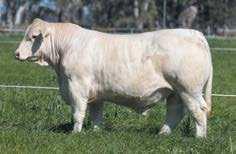

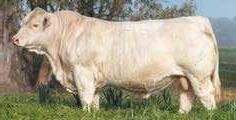
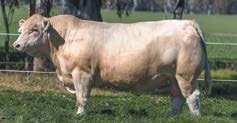


By Fiona Gowers
Queensland’s corporate community rocked cowboy hats and boots in July to celebrate Big Dry Friday, a cause that helps bridge the gap between city and country.
In its seventh year, the initiative raised more than $1.5 million, bringing the total funds raised to $7.7 million since its inception in 2018.
The Morgans Foundation has pledged to match all donations dollar-for-dollar this year up to $350,000.
Funds will directly support key beneficiaries: Rural Aid, the Royal Flying Doctor Service, Schools Plus and Outback Futures, as well as other local charities that support education, mental health, healthcare and disaster relief in rural and regional Australia.
Morgans Financial Limited launched Big Dry Friday during one of Australia’s most severe droughts to create awareness of the difficulties regional and rural Australians faced and provide vital funds to where it was needed most.
Big Dry Friday this year expanded its reach, hosting simultaneous events in Brisbane, Melbourne and Sydney.
Morgans executive chairman Brian Sheahan said Big Dry Friday 2024 returned to continue the vital support for Aussies living regionally and rurally.
“Big Dry Friday is a day to connect city and country and to provide support where it’s needed most,” he said. “We saw a great response from corporates and individuals.
“Big Dry Friday began during one of the worst droughts our country has ever seen and, while the rains have come, the challenges facing rural and regional Australians are harder than ever, which is why Big Dry Friday now focuses on creating long-term benefits for rural Australia by supporting education, mental health and wellbeing.
“We want to remind those in rural and regional communities that their efforts in supporting everyone living in the city, are recognised and appreciated, which is why we encourage city people to donate what they might spend on a lunch or drink and donate it to the cause.”
Big Dry Friday highlights were a lively auction and haybale stacking competition, all set against the picturesque backdrop of the Brisbane River.
Guests included Adam Giles, CEO of Hancock Agriculture, whose S.Kidman business donated more than 90 pairs of Rossi boots for raffle, former Australian netball player Laura Geitz, Queensland Reds players Taj Annan and Suliasi Vunivalu and Rural Aid CEO John Warlters.
Please visit www.bigdryfriday.com.au/getinvolved to donate.
Facts
• Big Dry Friday isn’t just another day on the calendar; it’s a lifeline for charities making a real impact in rural Australia.
• The impressive funds raised at the events are a testament to Australians’ deep compassion and solidarity, demonstrating a successful bridge between city and country to support rural and remote areas across the nation.
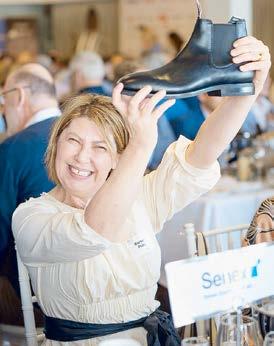
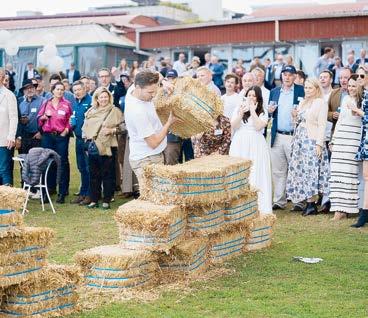
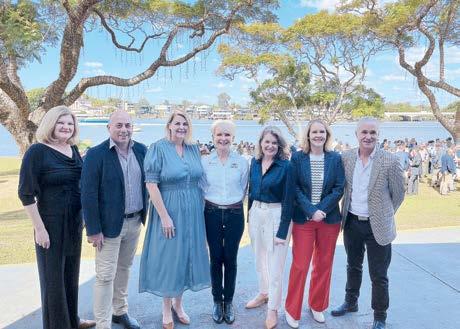
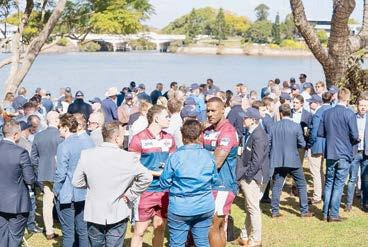

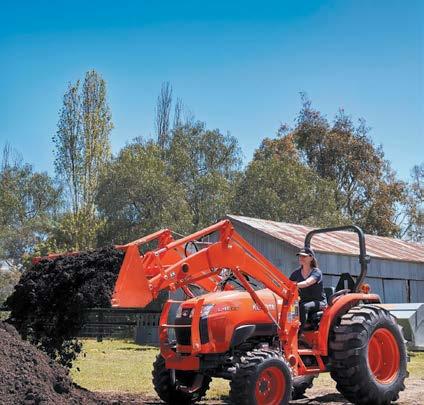

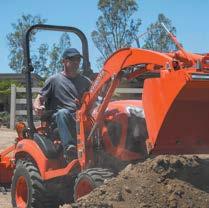

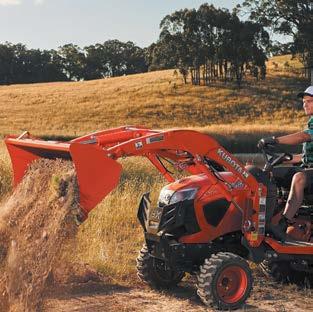
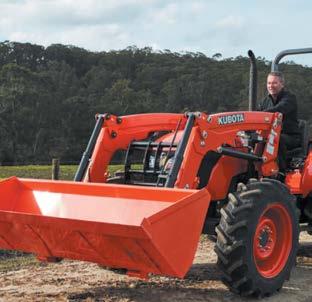

With many Red Angus-cross cattle making the front row at the 2024 Ekka led steer and heifer competitions, now might be the time to introduce some Red Angus genetics to your beef herd.
Renowned worldwide for calving ease, maternal excellence and carcase qualities, a great selection of bulls, females and genetics will be offered at the Power of Red X sale at the Toowoomba Showgrounds Equestrian Arena on 14 September, starting at 11am.
In all, 29 bulls, nine females and five genetic lots will be sold from 11 different vendors in Queensland and NSW, providing buyers with a great range of options to choose from.
Maryanne Kearney, Boonyouin Reds, is once again presenting a strong line up of bulls (Lots 6 –8, 28 and 29) and semen (Lots 42A and 42B). AfoundingmemberofthePowerofRedgroup, the Boonyouin bulls are always in demand.
Kirrily and Brooke Iseppi, GK Livestock, Dalby, are again putting up a strong line-up of Red Angus genetics. Another of the inaugural exhibitors, the Iseppi lots will no doubt be keenly sought.
Bulls (Lots 25 and 26), females (Lots 36 and 37) and genetics (Lot 42) will be offered.
Heather Davies, Rosemullion Red Angus, Goomburra, Queensland is the third and final founding member of the original POR I sale in 2015.
Heather is again one of our volume vendors offering another great draft of five bulls (Lots 10 – 12, 22 and 23).
Amelie Martin, AKM Red Angus, Stony Creek, Queensland is offering two bulls (Lots 13 and 14) at this year’s sale.
Amelie is one of our Red Angus junior members and is breeding some lovely cattle with the help and support of other POR group members.
Caleb Denning, DPC Red Angus, is one of three first-time vendors at this sale.
Based at Pittsworth, Queensland, Caleb is of-
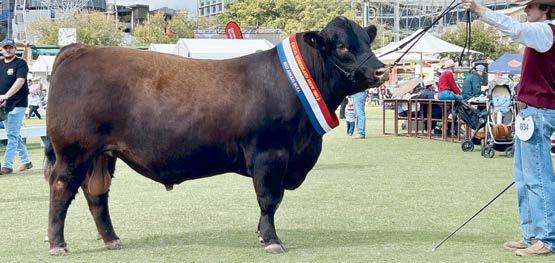
fering one bull (Lot 15), and two heifers (Lots 31 and 32).
Julie and James Brophy and family, Jillibry Red Angus, Meringandan West, are returning this year to offer a single bull (Lot 16).
Allan and Lucie Brown, Keen Edge Red Angus, Pittsworth will offer both bulls (Lots 17 and 24) and a heifer (Lot 30).
Peter and Trina Redgwell are first-time vendors at this year’s sale. Their Heartland Red Angus operation is based at Tamworth, NSW. The Redgwell family will offer one bull (Lot 9) and one heifer (Lot 38). The POR group wishes the Redgwell the best of selling at their first sale with us.
The Knee family’s Mellowood Red Angus, Loomberah, NSW is one of our visitors from south of the border. They will offer three bulls (Lots 5, 18 and 19) and one female (Lot 35).
Lachlan Moore, Moorevale Red Angus, Langley Vale, NSW is another of our Red Angus junior members forging a path in the breed. Lachlan was a strong buyer at the 2023 POR IX sale and hopes to share some of the genetics bought at that sale. Lachlan is selling one bull (Lot 27) and an embryo package (Lot 39).
David and Ashleigh Hobbs, Round-Em-Up/ Moorwatha Red Angus, Molong, NSW will offer six bulls this year (Lots 1 – 4, 20 and 21). They will


14 Sept 2024 - 11am



also offer two females (Lots 33 and 34) and one semen package (Lot 40).
An online version of the sale catalogue is available on the Red Angus website (www.redangus. org.au) or on the Stocklive website. (www.stocklive.com.au)
Nutrien Toowoomba are the selling agents and interested bidders can bid on the sale lots either live at the Toowoomba Showgrounds, via phone through Nutrien livestock or online through Stocklive.
* The Power of Red X sale is at the Toowoomba Showgrounds Equestrian Arena on 14 September, starting at 11am.
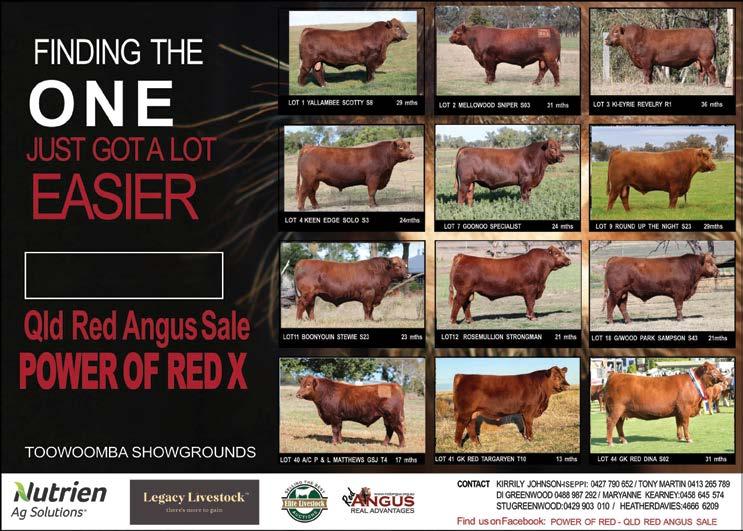











To be sustainable, Bulliac Angus principal Ben Hill maintains beef producers must have cattle that are efficient, fertile and structurally correct, allowing them to optimise and maximise the years of production possible from their investment.
“Sustainability shouldn’t come at the cost of profitability,” he said.
“Business can move forward whilst meeting consumers’ demands for eating quality and environmental expectations.
“The continuing global demand for protein and increasing population means we, as beef producers here in Australia, must play our part in this supply chain in a way which is responsible and sustainable.
“After visiting the Food and Hotel Asia Expo in Singapore last year it was evident that our beef is highly regarded. We must ensure we continue to maintain this position into the future.”
According to Mr Hill, Angus cattle offer the producer the benefits of meeting MSA requirements, plus earlier finishing and provide an ideal genetic solution for those choosing to be a part of the Emissions Reduction Fund under beef cattle management.
Mr Hill heads a bull breeding operation different to most.
It comprises females owned by the Hill family and run on the property “Wandaloo” at Miles and agistment that suits the environmental and biosecurity requirements of the operation, plus production units owned by the Bidgood and Swenson families.
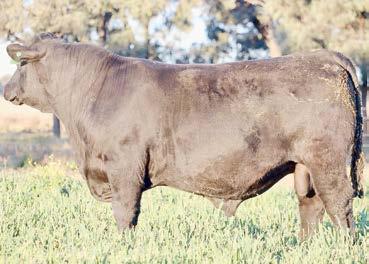
“Our bulls go out and work in some of this country’s harshest environments and not just survive but thrive.
“We raise our bulls so they have the ability to forage. We want them to have eaten the broadest range of grasses and feeds possible, so they are fit and ready to get cows in calf.”
Mr Hill spends a large amount of time searching for sires to create the bulls Bulliac offer. All are all genomically tested and parent verified,
“We’re trying to take the guesswork out as much as possible,” he said. “We want to provide bulls that will perform as described.”
He added that for northern producers to get the greatest benefit from using Angus genetics, they needed to retain the females.
The Hills have focused on ensuring their bulls are capable of producing daughters that can be retained and will work in tougher environments.
“We keep a lid on milk and growth,” Mr Hill said. “The fastest way to get empty females is too much milk and growth in this environment.
“We have one client based in Far North Queensland who remarked just how much the bulls grew out in that environment and thought they would be able to survive anywhere.”
This year’s sale of 130 bulls will also include three bulls from Nanango State High School whose herd is founded on Bulliac bloodlines. They continue to use sires from the Bulliac sire battery.
Bulliac has bred registered Angus for more
The agistment and production units allow for increased numbers of bulls to be produced under the Bulliac management ethos. All weaner bulls arrive off mum at “Wandaloo” for their development to a sale bull.
than 30 years and this year will be the 11th onproperty sale held at Miles.
Bulls have previously sold across Queensland and NSW and buyers can attend in person or bid online at either Auctions Plus or Stocklive.
“We believe in providing bulls that will ultimately make our clients more money,” Mr Hill said.
* The Bulliac Sale is on 26 September at 1pm. Bulls will be available to view the day before or by appointment.
* Free morning and afternoon tea and lunch will be provided, with Elders as selling agents.
* A four per cent agents’ rebate is in placeconditions apply.

RHS - NEAR NEW - TUBE EA/LEN
130 - 2.4M- 40X40X1.6- PTD -$10
700 - 2.4M- 50X50X1.6-PTD -$12
500 -2.4M-50X50X1.6-GALV -$14
29 - 8M -50X50X3-PTD -$100
80 - 8M -75X75X3-GALV -$170
80 - 5.8M-75X75X3-GALV -$120
140 - 3M -75X75X3-GALV -$65
208 - 2.9M-75X75X3-HDG -$65
202 - 2.9M-75X75X4-HDG -$80
116 - 2.9M-89X89X3.5-HDG -$80
215 - 3M -75X75X3BLACK POWDERCOATED -$80
50 - 6M -75X75X3-PTD -$110
123 - 4M -50X25X2-PTD -$25
59 - 6M -100X80X3-PTD -$120
32 - 8M -100X50X2.5-GALV -$140
32 - 8M -100X50X2-PTD -$100
24 - 4.7M-127X51X3PTD -$100
CATTLE PANELS
•1.8MX2.1M -6RAIL
•40X40 -GALVRHS
•PINSINCLUDED $75EA GOAT PANELS
•1.2MX2.2M •8RAIL -GRADUATED
•25MMOD -PIPE PINSINCLUDED $90EA



GALV PIPE
•6.5M-15NBX2.6MMWALL $18EA
•6.5M-20NBX2.6MMWALL $20EA
GATES - GALV
•10' -3M -MESH -$120
•12' -3.6M -MESH -$140
•14' -4.2M -MESH -$160
•10' -3M -5BARLIGHT -$140
•12' -3.6M -5BARLIGHT -$160
•14' -4.2M -5BARLIGHT -$190
•12' -3.6M -5BARHEAVY -$180
•14 -4.2M -5BARHEAVY -$210
RHS NEW NEW - TUBE EA/LEN
22 -8M-89X89X5 -PTD -$200
6 -8M-100X100X3 -PTD -$160
34 -3M-89X89X6 -GALV -$90
28 -8M-125X75X5 -PTD -$300
RHS - 2ND - GRADE - EA/LEN
9-8M-125X125X4 -GALV -$230
9-8M-125X75X4 -GALV -$200
9-8M-100X100X6 -PTD -$240
CATTLE RAIL - GALV
•115X42X2 -$65
•115X42X2.5 -$75
BUNALES21X6.1MLENS
STRAINER POSTS
•2.4M-80NBX4MM-GALV $75
•3M -80NBX4MM-GALV $90
•2.9M-80NBX5MM-PTD $80
•3.0M-80NBX5MM-PTD $85
ANGLE PIPE STAYS
•3.2505ONBX3MM-GALV -$44
LARGE DIA. PIPE BLACK EA,
•6M -273ODX9.2MM -$450
•6.3M -219ODX4.8MM -$300
•6M -273ODX6.4MM -$400
•6M -219ODX4.8MM -$300
•6M -168ODX6.4MM -$300
BARBED WIRE
•400M-2.5MMIOWA -$135
•500M-1.8MMHIT -$115
FENCE POST PICKETS
•165CM(5'6") -BLACKHEAVY -$8
•180CM(6') -BLACKHEAVY -$9
•180CM(6') -HDG-GALV -$10
•240CM(8') -BLACK-MASSIVE -$16
CATTLE CABLE
•8.2MMX7STRANDGALV
•400MX150KG $550
HINGEDJOINT/FIELDFENCE/ FIXEDKNOT ALLSIZESAVAILABLE
CATTLE GRID HEAVY
•4MX2M-800KG -$2700
CONCRETEABUTMENTSPAIR
•4M-3000KG -$1500

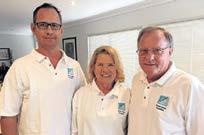



50X6

U-BEAM-12M
•150UB14- $500 •200UB29 - $1000
•150UB18- $650 •250UB25 - $920
•180UB16- $570 •250UB31 - $1100
•180UB18- $650 •250UB37 - $1300
•180UB22- $800 •310UB32 - $1100
•200UB18- $650 •310UB40 - $1450
•200UB22- $800 •310UB46 - $1650 •200UB25- $920 •360UB44 - $1600




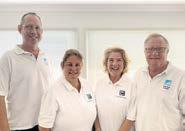

Carabar Angus stud was established in 2001 by Darren Hegarty at Meandarra and strives to produce top-quality Angus cattle that suit the Queensland environment and MSA standards.
The Hegarty family have a long history of being graziers going back generations from Dirranbandi, Bollon and Brewarrina.
Darren Hegarty’s focus is on breeding and producing quality Angus MSA-grade cattle for superior structural soundness, eye muscle, intramuscular fat (IMF), growth potential and temperament.
“I believe it’s the durability and longevity of Carabar bulls that really stands out to our clients,” Mr Hegarty said.
Carabar specialises in Angus genetics, selecting only the finest bulls and females for its breeding program.
At the eighth bull sale at Carabar, 74 bulls will be offered - 45 T bulls and 29 younger U bulls.
Sires of the bulls include, Premier Hingaia Q63 with 19 sons, Texas Iceman R725 with nine sons, Carabar Lotto N31 with eight sons, Ferguson Trailblazer 239E with two sons, Murdeduke Quarterback Q011 with two sons and Carabar Jumbuck M182 with eight sons.
Carabar Judge J22 and Carabar Mascot M42 each have six sons and Carabar Reality N103 seven sons.
Gar Phoenix, HF Alcatra, Brooking Firebrand 6068 and Carabar Gunsmoke are also represented.
“These bulls possess the superior structural soundness, eye muscle area, intramuscular fat, growth potential and temperament, that our bulls are well known for,” Mr Hegarty said, adding that these Angus bulls stamp their progeny with superb conformation and performance.
“These attributes are equally important in establishing a quality cattle breeding program.
“To that end, we have purchased some of Australia’s finest bulls, augmenting our own breeding cattle with semen from championship Angus
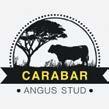

stock from all over the world.”
When founding Carabar, Mr Hegarty sourced top-of-the-line genetics from the Kansas, Lawsons and Booroomooka Angus studs.
Mr Hegarty said the sale had held its appeal due to the durability of the bulls offered, in combination with true value for money buying opportunities.
Upcoming bull sales for 2024 are Carabar Angus on-property sale on 27 September and the Blackall Carabar Bull sale on 29 October.
Bulls can be viewed at Carabar or on our website www.carabarangus.com, Carabar Angus Facebook page and AuctionsPlus site where there will be a video of each bull, as well as photos.
The sale will be integrated with AuctionsPlus.
All bulls have been examined and semen tested. Each have had injections of seven-in-one, three-day, Pestiguard, Vibrovax, Long Range and three germ blood and tested negative for pestivirus.
To inspect the draft pre-sale day, please call Mr Hegarty on 0428 748 542, (07) 4665 6164 to make an appointment.
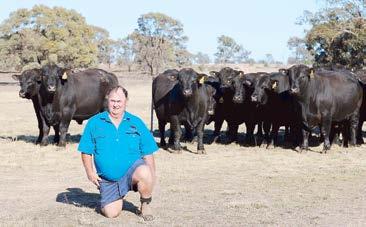
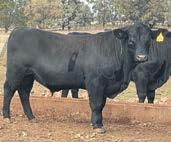


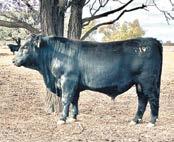



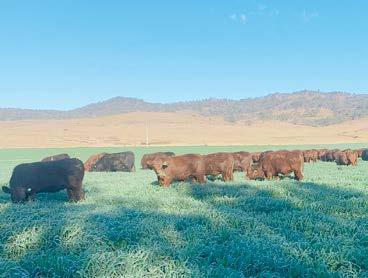
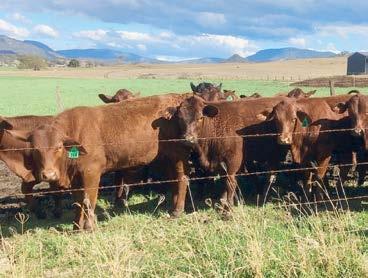
By Breanna Lloyd
Graziers Justin Paton and Kate Cahill of “Mooribinda” of Christmas Creek outside Beaudesert are astonished by the performance, class and allaround qualities of their top-tier bulls purchased from Talgai Santa Gertrudis.
Justin and Kate operate a grazing property, which runs 120 Santa Gertrudis and Santa crossbreeders in their farming operation.
Being in the early stages of a primary producer, Justin and Kate searched profusely for suitable Santa Gertrudis bulls to put over their heifers.
Looking for their preferred qualities of tem-
perament, clean progeny and overall high quality, Justin said they had finally come across a breed that had it all.
“We are always excited to see what the progeny will be like,” he said.
“The temperament of all the bulls is faultless and the weight gain has been absolutely exceptional.
“All of the Talgai bulls we have purchased have a very clean coated progeny.”
Before purchasing Talgai bulls, Justin and Kate found problems with calving but soon discovered problem-free calving since they began using Tal-
gai bulls.
Having now bought from Talgai for two years, Justin said he was extremely happy with all of his purchases.
Talgai Santas is owned by Max and Roz Baldwin and managed by Malcolm and Chick Gadsby.
Home for Talgai Santas is based at “The Gorge”, a 2164-hectare block in the Nindooinbah area outside Beaudesert.
The stud aims to breed high-growth, wellmuscled and easy-finished Santas that meet market specifications.
“I’d like to thank Malcolm and Chick for helping us secure the right bull for our needs,” he said.
to their roots and continue breeding with Santa Gertrudis cattle.
“I thought that sticking with what I know best would benefit our operation in the long run,” Justin said.
“So far, breeding Santa Gertrudis has been beneficial for us, especially now we have Talgai blood amongst our breeders.
“We are excited to see what the future holds.”
Since utilising Talgai Santas, Justin and Kate noticed their weaners have produced a significant amount of weight gain and growth and, to further this, have implemented a small farming operation of oats, grain and ryegrass.

“Overall they have been great to deal with.”
Justin grew up on a Santa Gertrudis operation in central Queensland and Kate was born and bred in the Christmas Creek area, on the property which they now both call home.
Instead of breeding their original Brangus and Shorthorn herd, Justin and Kate decided to stick


“We have had the luxury to boost our herd’s weight gain, thanks to the Talgai bulls and continue producing enough feed to keep up with them,” Justin said.
After Justin and Kate are satisfied with their weaners’ weight gains, they are trucked to nearby sale yards and abattoirs.
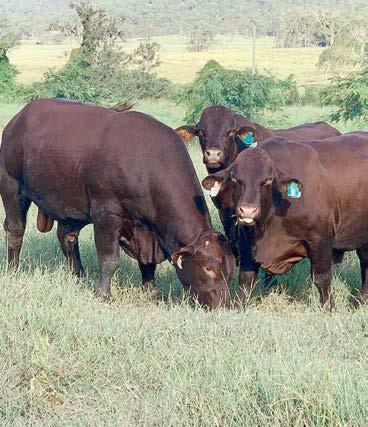
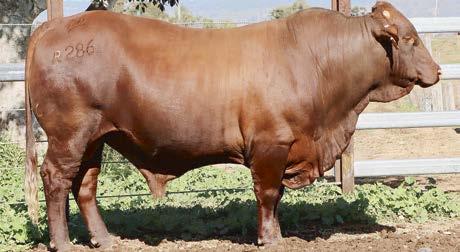

Third-generation Santa Gertrudis breeders Kendall and Brigid Bassingthwaighte of Yabba Pastoral Company, Kilcoy have bought bulls from the Brisbane Valley Santa sale in the past.
The Bassingthwaightes run commercial Santa Gertrudis cattle, turning their grass-fed feeder steers off at about 500 kilograms to the local feedlot market.
Each year they retain some replacement heifers, with those relinquished also turned off to feedlots at about 400kg.
Kendall said he focused on his herd’s temperament to keep his family safe and, as such, prioritises the temperament of the bulls he buys.
He believes there is a direct correlation be-
tween temperament and doing well.
Having grown up with Santa Gertrudis cattle, Kendall feels they are adaptable to the climate and market conditions.
“I find because they adapt so well, that they are also easier to sell into any market, so we always have a market for our cattle,” Kendall said.
The Bassingthwaightes prefer the larger frame of the Santa, as it gives them plenty of room to grow, they also seek their structural correctness. Reproductive soundness is also important, with easy, strong calves that are highly resistant to many common issues.
Santa Gertrudis cattle have an excellent reputation in the feedlot market for doability and high
yielding carcass performance as they adapt easily and quickly to a wide range of climatic conditions.
Yabba Pastoral Company buys Santa bulls annually and the Brisbane Valley sale is one of the sales that they attend each year to source quality bulls.
The Brisbane Valley Santa Gertrudis sale will offer 73 lots in total, with 69 bulls and four heifers.
The sale starts at 12.30pm on Wednesday 18 September at the Toogoolawah Showgrounds and on AuctionsPlus.
Shepherdson and Boyd is the sales agent
All sale bulls are inoculated for vibrio, sevenin-one, three-day sickness and blooded prior to


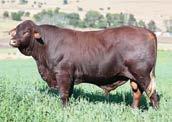
the sale date. The vendors under this year’s spotlight are some of Queensland’s most prominent Santa Gertrudis studs: Russell and Robyn Gray, Arioca, Linville, Queensland, Dave and Lacey McCabe, Coulsonview, Boonah, Queensland, Rod, Margaret, Ross, Louisa and Sara Wilson, Hayleigh, Durong, Queensland, Max and Roz Baldwin, Talgai, Nindooinbah, Queensland, Howard, Flo and Jeff Beutel, Boonah Queensland, Scott and Therese Humphreys, Welbatch, Mummulgum NSW and Neil, Lance, Kym Baker and family, Woodmillar, Gayndah, Queensland. The invited vendor is Taylor and Darby Humphreys, Bellview, Mummulgum, NSW.





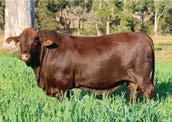


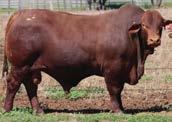

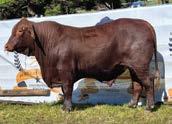

The voices of 1000 rural women are being sought for a groundbreaking new documentary on Australia’s rural, regional and remote women.
Rural Daughters, the feature-length documentary by award-winning CheekyMac Productions, will follow the personal journeys of some of Australia’s most inspiring rural women in their efforts to overcome barriers, effect change and live a successful, purpose-driven life in the regions.
In addition to their stories, a nationwide 1000 Rural Women Survey has been developed to capture the experiences of rural women on a broad range of topics from natural disasters, health and domestic violence to societal attitudes, racial prejudice, Tall Poppy Syndrome, community life, leadership and female role models.
The documentary and survey is the brainchild of producer, director and writer Danielle McAlpine Johnson, herself a rural woman from Gippsland, Victoria.
Mrs McAlpine Johnson aims to garner more than 1000 survey responses to provide a statistical snapshot of rural women.
“Surveying 1000 rural women is a bold target, but we hope women take this opportunity to tell us about their lives and be a part of a collective voice in the Rural Daughter’s story,” she said.
“These women are the backbone of rural Australia and we are putting our heart and soul into telling their stories - how they overcome adversity, find purpose, break limitations and lead in their communities in the most unique and innovative ways.”
The survey has been developed by Federation University’s Collaborative Evaluation and Research Centre, together with CheekyMac Productions - both organisations led by rural
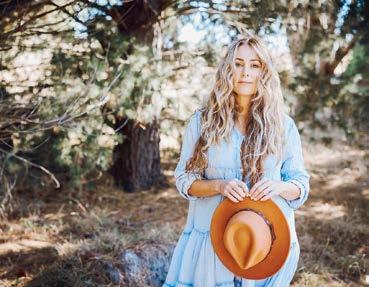
women.
Commissioned by the Community Enterprise Foundation, the survey is expected to be the largest and broadest of its kind.
“Our involvement in this documentary is an opportunity to showcase that a regionally-based
university can make a difference with regional communities and, in particular, advocate for rural women on issues that matter,” CERC Professor Joanne Porter said.
The documentary and survey results are expected to be used to inform policy and develop
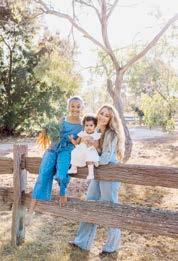
educational resources in Australian schools.
The survey is available online between August and September and can be found at cheekymac.com/rural-daughters
To request hardcopies, contact CERC@federation.edu.au
By Breanna Lloyd
From learning how to ride a horse as soon as she could walk to now holding the 2024 CQ Showgirl title, 19-year-old Emily Wickham believes she has certainly achieved one of her very many goals.
Originally from Singleton, New South Wales, being a rural Showgirl has always been something Emily wanted to tick off on her to-do list.
Through her new role, Emily seeks to grow in her confidence and endeavours to flourish in the agricultural industry more than she already has.
“If someone told me five years ago this is what I would be doing, I would be so proud of myself,” she said.
“Keep reaching for the stars and dreaming big you never know what you will achieve.
“I never expected to go so far with the show-


girl competition and I’m so excited for what is to come.”
During her schooling years, Emily decided to incorporate agriculture into her home and school lives.
It first began when she started the high
From there, Emily got more involved with the camp drafting world and quickly became run off her feet.
Emily’s passionate side for competitiveness shone through when she competed in camp drafting.
Hence, when her mother asked her to decide which sport to continue, she chose camp drafting.
“Growing up in my hometown, I would see the Showgirls each year and their achievements,” Emily said.
“It all quickly became an inspiration to me, especially because agriculture is a significant passion of mine.”
Now residing in Cawarral, Rockhampton on a relative’s small property, Emily works full time as a student in nursing and participates in any agricultural show and camp draft she can at-
tend, while constract mustering on the side. Emily first discovered her love for Central Queensland after participating in the regions biggest campdrafts, Paradise Lagoons with her grandfather.
“My grandfather and I would make Paradise Lagoons our annual road trip,” Emily said.
“That’s how I began to love the region and eventually I decided to move here.”
In the future, Emily hopes to continue her nursing career throughout Central Queensland while promoting the CQ Showgirl title.
“Anyone involved in agriculture or interested in agricultural shows and who doesn’t mind public speaking should give it a go,” she said.
“It gives you such a powerful voice to use and it helps you foster community connections with the young and old.
“Its about promoting what you love most, agriculture.”

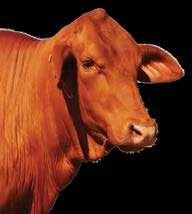

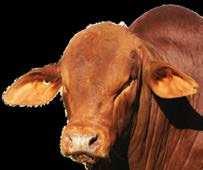



By Fiona Gowers
Condamine sisters Claire and Hannah Morgan relied on the equestrian experience gained on their family farm Arubial to help them conquer the Mongol Derby, the world’s longest and toughest horse race.
On 7 August, both embarked on a 10-day ride, spending 12 hours a day in the saddle across 1000 kilometres of Mongolia’s vast, isolated wilderness.
“It was a once in a lifetime experience,“ said Claire.
“Being able to travel while doing something in the realm of what we’ve grown up with here at home with horses and pushing ourselves to our personal limits - and doing it together - just added to the experience.
“We understood and appreciated that, no matter how prepared we were, it was going to be difficult. We were taken out of our comfort zones.
“But, it was such a cool thing that we are really grateful to be a part of.“
For Claire and Hannah, participating in the Mongol Derby was the culmination of a lifelong passion for equestrianism. Growing up on their family property mustering and campdrafting, they relished the chanced to take their horsemanship to the next level.
Training for the derby involved riding 40 to 80km daily to build endurance but, as Claire said, the biggest challenge was actually squeezing 10 days of essentials under the five kilogram weight limit.
“From clothes to sleeping bags, emergency/ medical kits, small gifts for the herding families, protein bars and electrolytes, it has been a challenge in itself fitting all that in under five kilograms,“ she said.
“I literally sat with the kitchen scales measuring each item one by one.
“We opted not to take an inflatable pillow because it weighed 82 grams and that could be allocated elsewhere.
“I also snapped the handle off my hair brush because that weighed 30 grams. My phone was 232 grams but that came to take photos!“
The Morgan sisters first encountered the Mongol Derby when a family friend completed the trek in 2019. Rather than intimidate them, the race inspired them.
“We were on a flight to Western Australia for a holiday with our cousin Maddie when we wrote and submitted our application,“ Hannah said.
“It was something that certainly had our ears pricked when we heard about it back in 2019.
“And, riding the momentum of the trip to WA, we thought ‘why not tick another adventure off the bucket list’?“
Claire and Hannah applied to The Equestrianists, the organisation that hosts the Mongol Derby, then crossed their fingers. They were confident they had the experience, determinationand sense of adventure - to be seriously considered.
After a year of waiting and interviews by the Equestrianists, both were among the 45 riders selected to participate in the 2024 Mongol Derby from about 400 applicants.
“Our interview process was staggered and we both got accepted at different times,“ Hannah said.
“We were stoked to find out we were going to be tackling the race together.
“The interview process is a few rounds and you are required to supply videos and photos of you riding so they know you’re a competent and capable rider because it [the race] will certainly test your abilities and your horsemanship skills.“ The Mongol Derby The Mongol Derby follows the postal route established by -Genghis Khan across the Mongolian Steppe in 1224. Horse messengers used the route so the leader of the Mongol Empire could communicate with the far-flung corners of his conquests.
The first Mongol Derby took place in 2009 and has been held annually since then.
Today, the Mongol Derby holds the record for the longest multi-horse race in the world. Participants ride “semi-wild“ Mongolian horses between roughly 30 stations along the 1000km route, switching horses at each station.
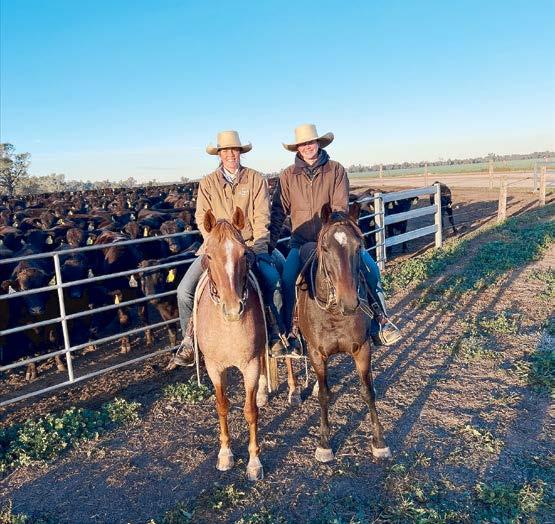
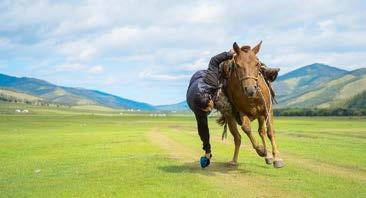
“It requires horsemanship and it requires endurance,“ Claire said.
You GPS your way across the unmarked route so you need to be careful not to misjudge a checkpoint or get lost.
“If you decide to camp overnight between stations to gain a time advantage, it’s up to you to look after your horse and yourself overnight wherever you are.”
Riders can only ride up to 12 hours daily and can be penalised if they’ve pushed their horses too hard. Medics and equine vets are waiting at each station, along with food and water for the riders and their horses.
The Mongol Derby is notoriously treacher-
ous and riders have been lost and injured during the race, sometimes to the point that they can’t continue. Simply finishing the derby is worth celebrating.
“It definitely is a race, like there is a first place and second place,“ Claire said.
“But, at the end of the day, they really encourage us to treat it like it the incredible adventure it is.
“Sportsmanship is also a core value of the event, so it’s not so competitive to the point where you see another rider in trouble and continue riding.
“Also, you stop at a horse station to change horses roughly every 30km. Each of those horse
stations is hosted by one of the families on the Steppe so it’s important to show your appreciation to them by having a chat and giving a small gift.“
The Derby also presents an opportunity to rally support for causes the riders care about.
Alongside fundraising for Angel Flight and TIACS locally, Hannah and Claire are raising money for Steppe and Hoof (steppeandhoof.org), a native horse preservation and veterinary education program in Mongolia.
Steppe and Hoof teaches herders basic animal wound cleaning techniques and gives them the tools and knowledge of modern veterinary medicine and animal practices.
How long does the Mongol Derby take?
For 10 days each August, the Mongol Derby recreates the legendary system, building a network of 30 horse stations at 30km intervals along the entire thousand kilometre course. Riders typically ride three horses per day, or 30 horses over the entire race. At each horse station, every horse is checked by the Mongol Derby vet team to ensure horses are in good health and physical condition. Horses are checked for soundness, heart rate recovery and any signs of stress. Vets may issue a time penalty to a rider whose horse does not pass the mandatory vet check.
Rules of the Longest Horse Race in The World
• Each rider has an overall weight limit of 85kg (dressed to ride).
• Each rider is allowed to bring 5kg in personal gear in backpack (excluding water).
• Each rider is issued a custom race saddle, bridle and blanket.
• Race hours are from 7am to 7pm.
An outstanding draft of 85 Droughtmaster bulls are catalogued for the 11th annual Bunya Bull Sale to be held at the Coolabunia Selling Complex, Kingaroy, starting at 11am on Saturday 7 September.
Bunya Sales Committee chairman Graham Brown said 30 vendors would offer bulls at this year’s event.
“Our vendors have assembled a quality draft of young bulls for the competition of prospective buyers,” he said.
According to Mr Brown, this sale has always provided the best value for money bulls in the Burnett.
In 2023, 48 per cent of the bulls found new homes for $5000 or less, highlighting the reputation as the best place to find quality bulls at affordable prices.
“It doesn’t matter if you’re looking for a stud sire or a good commercial bull, plan to attend the sale and you won’t go home disappointed,” Mr Brown said.
This year, sale vendors will present all registered bulls with DNA sire verification, horn/poll testing, as well as tested free for Pompes. Bulls will be weighed, mouthed, scanned and, at a minimum, carry a 60pc semen motility test. Most will be morphology tested in 2024.
This year’s draft will also see the highest number of bulls offered with Breedplan performance data in the sale’s history.
Bulls will present as 99pc polled or homozygous polled.
Online bidding will operate for those who can’t attend the sale through the Stocklive Elite online bidding platform.
Details of how to access and register with Stocklive can be found within the 2024 Bunya catalogue.
Pre-sale inspections are invited with all bulls being available for viewing from 3pm on Friday 6 September.
The catalogue is available for viewing online by visiting the sale website bunyasales.com.au or like

the Facebook page to keep up to date with the latest photos and videos of the draft.
Sale vendors will offer many incentives, including bulk buyer rebates to buyers of five or more bulls.
Free delivery on all lots purchased is available to the following centres – Eidsvold Saleyards, Big-
genden Saleyards, Beaudesert Saleyards, Gympie Saleyards, Dalby Saleyards and Toogoolawah Saleyards.
A four per cent outside agent rebate is also offered to any agent introducing buyers prior to the sale. Details of these offers can be found in the catalogue.
All bulls will be pre-scratched before the sale to enable them to travel to tick-free areas immediately following the sale.
For a catalogue contact GDL’s Mark Duthie on 0448 016 950, ALL’s Midge Thompson on 0427 710 018 or sale chairman Graham Brown on 0427 779 707.
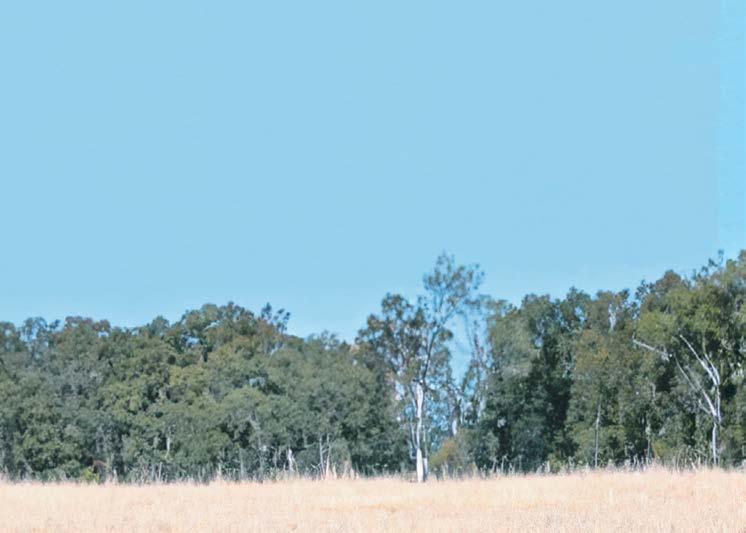

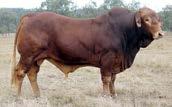

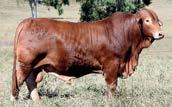

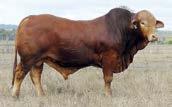
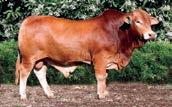
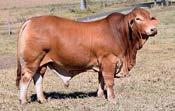
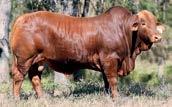
By Breanna Lloyd
Reliability, longevity and quality.
Those are the three words that Mooroobie Angus uses to describe their incredible lineup for their annual bull sale in September.
The lineup consists of 14 two-year-old Angus bulls, two 24-month-old Wagyu bulls, 32 16-17 month-old Angus bulls and six 16-17 month-old Wagyu bulls.
The two-day sale will commence at 9am Wednesday 18 September and will conclude at 2pm on Thursday 19 September on AuctionsPlus.
Potential buyers are urged to attend the open day at 10am on Tuesday 17 September at Mooroobie, 5km southeast of Goondiwindi.
Stud owner Lindsay Ward said the junior bulls approaching 18 months - Q494 and R102 - were the predominant sire lines.
“These sires have proven to be outstanding,” Lindsay said.
“They are exceptional offerings with high grading and outstanding breed plan numbers.”
The majority of the bulls have been assessed as grade seven, eight being the perfect animal structurally and phenotypically, by IBMS Dick Whale from Wangaratta.
Lindsay added that the T and U bulls have been fed appropriately.
“Our T bulls have been grazing Kracken forage barely with oaten hay and the U bulls have been fed a ration developed by our animal nutritionist Vincent Posada,” Lindsay said.
Igenity testing was conducted on the 16 and 17-month-old bulls to determine their strengths and weaknesses.
Who is Mooroobie Angus?
The Ward family have resided on part of Mooroobie since 1902.
Lindsay and Helen Ward established Mooroobie Angus in 1995 and Mooroobie Wagyu in 2016.
While managing the two studs, the Wards
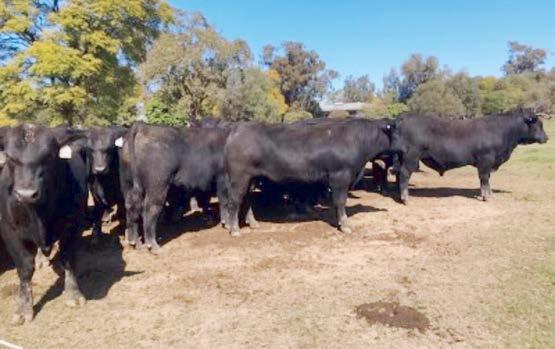
grow dryland and irrigated grain and forage crops on Prestbury, located between Felton and Southbrook, which they purchased in 2017.
The Ward family run 400 Angus stud cows through AI and ET programs annually, while also running a commercial herd with progeny
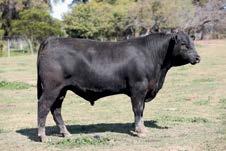

This allows the Wards to monitor their herd for temperament, working ability, retail beef yield, marbling and fat scores.
The decision to incorporate Wagyu into their herd was made due to the increased demand for
a high record in fertility and offering ease in calving, the
Wagyu bulls are now used over the Wards commercial Angus heifers to produce F1 calves.
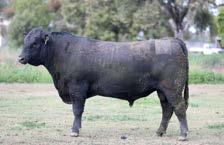
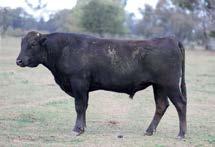
For Bruce and Sherry Lowe they have balanced their working lives with something they both lovefarming in the Mary Valley. ERLE LEVEY went along to their property to learn more about dragonfruit, bee-keeping, and growing herbs and vegetables.
Balancing work and life can be hard, especially with the demands of the modern world.
Yet for Bruce and Sherry Lowe it is easier because they both do what they love - whether that be at work or at home.
Both grew up in the Mary Valley and now live and work in the area every day - except when Sherry’s role as general manager of the Mary Valley Rattler calls her away to promote not just the heritage tourist train but the wider Gympie region.
Yet again, it’s something she is passionate about.
Just like their property at Bells Bridge - which is where I find them on a Sunday morning.
It needed to be Sunday due to Sherry’s other commitments, particularly endurance horse riding.
That is Sherry’s way of putting work into perspective - just her, the horse and riding through such a beautiful landscape as the Australian bush.
Our catch-up needed to be before the end of June as the dragonfruit crop was almost finished for the season.
Bruce has been balancing getting the fruit off the vines with his work as a mobile mechanic, mainly for farm machinery.
Ningana is a 16-acre property the family use as a combination of grazing land, orchards and for a tunnel shelter to grow herbs and vegetables.
They grow dragonfruit, harvest honey, herbs and vegetables, as well as keeping a small flock of sheep.
The property is predominantly north-south with the slope to the north-east, and a dam in the valley.

There are about 200 posts for the dragonfruitwith four vines on each.
Most are planted on the north-east slope with some across the dam, amongst eucalyptus trees for filtered light.
Dragonfruit use aerial roots to climb up
large posts or tree trunks, and they get moisture from the air. Bruce designed the posts for their orchard - made from concrete so as to get four vines to a post.
He was introduced to the fruit by his father Henry, who was growing a few at his home.
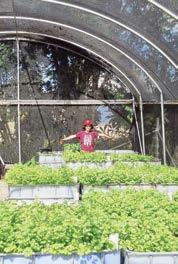
“I always had an interest in it. We’ve always wanted to get into some sort of farming and this ticks a few boxes.
“You don’t need highly fertile soil, they’re quite drought resistant.’’
Continued page 46
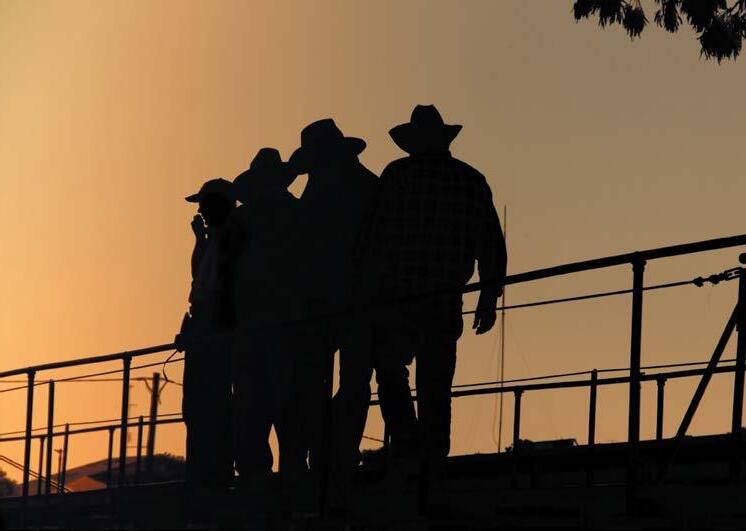
Do you have a story to tell, new projects to talk about or just simply highlight an achievement....
Fiona Gowers | E: fiona.gowers@queenslandfarmertoday.com.au
Breanna Lloyd | E: breanna.lloyd@queenslandfarmertoday.com.au
For all your classified and advertising enquiries, contact our team.
Jane Lowe
P: 0408 488 609
E: jane.lowe@queenslandfarmertoday.com.au
Samantha Wantling
P: 0439 420 289
E: samantha.wantling@warwickstanthorpetoday.com.au
Cindy Unwin
P: 0408 281 861
E: cindy.unwin@cqtoday.com.au
Daniel Pelcl
P: 0408 956 830
E: daniel.pelcl@burnetttoday.com.au
Classified Advertising
Sharon Jones
P: 07 4182 0451
E: sharon.jones@burnetttoday.com.au
17,000 copies published. Inserted into the following newspapers: • South Burnett Today
• Central & North Burnett Today
• Warwick Today
• Stanthorpe Today • Leader Today
• Jimboomba Today
• Beaudesert Times
• Emerald Today
• CQ Today
• Goondiwindi Argus
Also available from the follow outlets:
• Hartleys Newsexpress Toowoomba
• Roma Sale Yards
• Warwick Sale Yards
• Highfields News & Post
• Pittsworth Newsagency
• News Extra Central City
Next Edition out on August 29, 2024


Pathfinder Angus is thrilled to announce its highly anticipated bull sale on Friday, 20 September at the Roma Saleyards.
This year’s event will showcase an exceptional draft of 120 elite bulls, meticulously selected to meet the highest standards of quality.
Pathfinder bulls are chosen for their remarkable growth, superior carcase traits, solid structural integrity, docility and ease of management.
Each one has been vetted from a pool of 650,
ensuring that only the very best are offered.
This year’s line-up includes standout sire lines such as Nationwide N432, New Ground N90, Newly N549, Intensity L519, Paratrooper P15 and Quarterback Q11.
Under the dedicated guidance of Nick and Sara Moyle, alongside their daughter Elle, Pathfinder has established a reputation for breeding cattle that are both commercially viable and environmentally adaptable.
“We source the finest genetics from top Angus
herds across Australia, the USA and New Zealand to deliver cattle with exceptional calving ease, high growth potential, robust structures, outstanding fertility and superior carcase quality,” said Elle Moyle.
Celebrating a milestone of 10 years of auctions in Queensland and 68 years of serving outback Queensland, Pathfinder is honoured to offer our clients the pinnacle of breed excellence.
“We extend our gratitude to our clients, who are a vital part of our journey,” Ms Moyle said.
“Join us to explore our impressive lineup of bulls, characterised by their extra capacity, softness and exceptional carcase qualities.’’
For pre-sale inquiries or to schedule a viewing, please contact Cyril Close on 0428 222 208.
The auction begins at 10:30am on Friday, 20 September at the Roma Saleyards and online with AuctionPlus.
“We look forward to seeing you there,’’ Ms Moyle said.
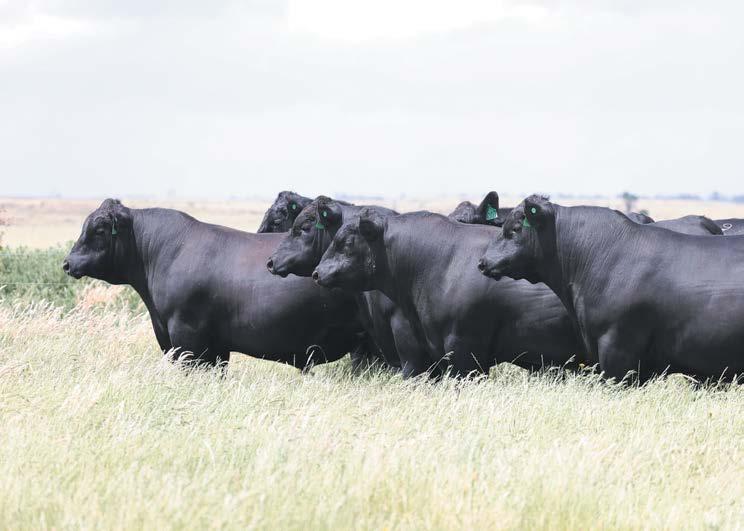
The performance of Glenisa Angus genetics was recently tested when the stud entered four pens of commercial steers in the highly-competitive and well-regarded annual RNA Paddock to Palate Competition.
“The competition is an opportunity benchmark ourselves amongst the leaders in the industry,” said Mr Wise.
In the weight gain section, Glenisa Angus’s top pen of steers placed fourth from 26 entries in Class 40, 100-day HGP free export with an average daily gain of 2.318kg.
In class 37, meanwhile, 100-day HGP export, their top pen placed eighth with an average daily gain of 2.575kg.
Being the inaugural year of entering the competition, the Glenisa team were thrilled with these results.
“Particularly with the the purebred steers,” Mr Wise said. “It cements the power of the Angus breed.
“This affirms for us that our herd is commercially viable and will be able to contribute positively to the profitability of your livestock operation.”
The awards night was held during the Ekka and Ced Wise, Ben and Sam Lobegeiger and Aline Teixeira of Glenisa Angus attended to hear the final results announced.
The competition included points for carcase and MSA eating quality and here the Glenisa Angus steers really shone, with Glenisa taking home many prizes including:
• Overall winner of Class 40 - RNA Paddock to Palate Competition
• Second in Class 37 – RNA Paddock to Palate Overall Winner
• First and second in Class 37C – MSA Eating Quality Competition
• Third in Class 40C – MSA Eating Quality Competition.
Glenisa Angus manager Ben Lobegeiger said: “We’re in shock. We’ve focused on performance
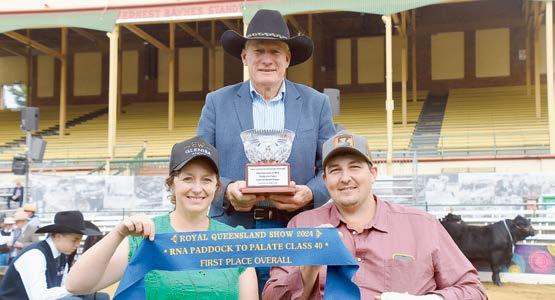
in our program and knew we’d be competitive but, to come away with the silverware, well that was something else.”
The focus of the Glenisa team now turns to their annual sale to held on property at Glenisa, Glen Aplin at 12pm on Friday 6 September.
A draft of 46 Angus bulls will be presented for your inspection.
Having been bred in the marginal Granite Belt district, the Glenisa bulls have been raised predominately on native pasture, some crop, and
have spent the past 90 days being fed a silagebased ration.
They are bred with growth, fertility, longevity and docility in mind.
For the first time through the Glenisa annual sale, a selection of Glenisa-bred commercial heifers will be offered.
With no commercial heifers retained, the draft of 50 Glenisa Angus commercial females represents the cream of the crop.
These 12-month-old females will be offered
in pens of 10 and are from the same herd as the steers who excelled in the RNA Paddock to Palate competition mentioned above.
For those unable to attend the Glenisa sale, videos are available by scanning the QR code or via our Glenisa Angus website. AuctionsPlus will operate during the sale.
Prior inspections of the draft are always welcome. Please don’t hesitate to contact Ben Lobegeiger on 0408 710 392.
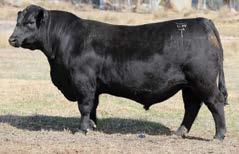
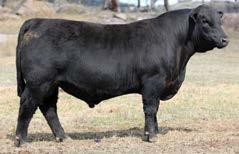

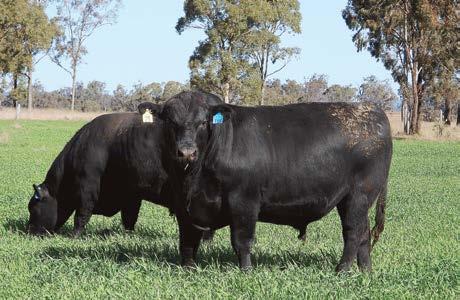
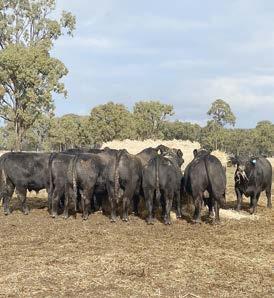
Warren and Lana Stiff will hold their third onproperty registered Angus bull sale on Friday, 6 September 2024.
Viewing will start at 10am, with the sale starting at 1pm.
Broadwater Angus was first registered with Angus Australia in 2015 but the Stiffs have been breeding and feeding beef cattle for the past 22 years.
Their combined industry experience and understanding of the cost drivers of feed lotting,

meat processing and the inherent values of meat quality have guided the daily decisions they make in the Broadwater Angus breeding program.
The Stiff’s aim to produce bulls that have a real ability to improve the dollar value at all levels of production.
On offer in September will be 10 two-year-old bulls and 40 16 to 22-month-old yearlings sired by leading US and Australian sires. Among other traits the selection of these sires has delivered a balance across managed birthweight, attaining

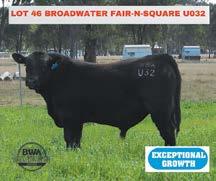
above herd average growth rates and maximising eye muscle area and marbling.
“We would like to welcome you to visit Broadwater and inspect our bulls on sale day or earlier (by prior arrangement),” Mr Stiff said.
“Offering both desirable phenotype and the genetic potential to improve a wide range of production traits, we are confident that the entire listing is quiet, fit-for-purpose and will prove to be affordable.
“Most importantly, we believe that these bulls
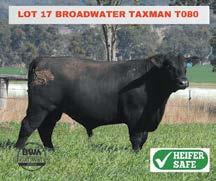
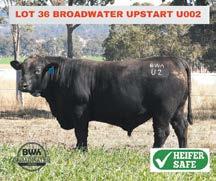
can deliver progressive genetics to your established breeding operations in the areas of most importance to you.”
The sale will be live streamed with online bidding available via AuctionsPlus.
A five per cent rebate is offered to introducing agents who contact the George and Fuhrmann selling team before sale day.
To request a catalogue and join the mailing list email wpstiff@gmail.com with your full name and mailing address.
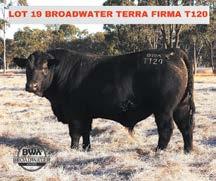



Practically growing up in the cab of her Dad’s Western Star Road Train, it is no surprise North Queensland singer-songwriter Josie followed a path into country music.
During those many long-haul outback journeys on open highways, Josie learned to not shy away from hard work – and boy can the music industry be that.
After attending the CMAA Academy of Country Music in 2018, Josie knuckled down and worked on releasing her debut single ‘Down Here’ in June 2023.
A few short months later, she followed up that release with the raw and personal ballad dedicated to her Dad, ‘Freight Man’.
This track started life as a songwriting project with Golden Guitar winner Travis Collins during Josie’s time at the CMAA Academy.
‘Freight Man’ went on to amass over 365,000 streams upon release and garnered her fans across the country.
Following a series of successful performances at the 2024 Tamworth Country Music Festival and rocking the Winton Way Out West Fest in April, Josie is once again turning heads for all the right reasons with the new crowd favourite, ‘Our Place’ - a song that oozes fun and encapsulates good times spent with family and great mates.
“If anyone has been to a party at my parent’s place, you’d know we don’t muck around when it comes to having a bit of fun. Dad cooks up a mean feed of brisket and top-notch bush snags. And Mum usually cranks up the music and we let our hair down no matter the occasion. The whole family usually invites just about every man and his dog out for a cheeky beer which often turns
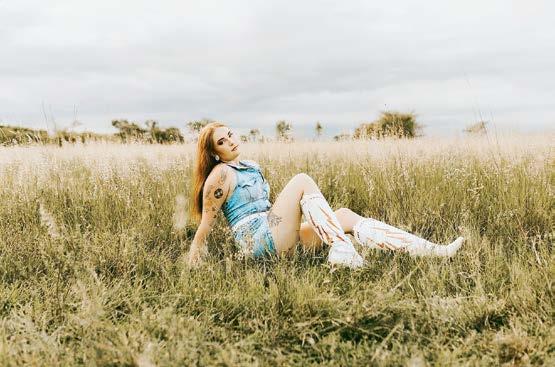
Queensland
into a 2am campfire jam session.”
Since its release ‘Our Place’ has already been bringing people to their feet on dirt dancefloors across Queensland and New South Wales.
“Getting the chance to perform live songs which used to only ever exist in my living room
is an experience I’ll never take for granted” Josie says.
As a fresh voice in Australian country music, Josie mixes grit with authenticity and relatability. Having supported country music giants like Troy Cassar-Daley, Brad Cox, James Johnston and
Lane Pittman, Josie’s star is certainly on the rise. With future goals including songwriting in Nashville and performing at CMC Rocks QLD, the rest of 2024 will see Josie releasing more new music and continuing to clock up highway miles across Australia playing gigs around the nation.
By Sharnae ‘Shaz’ Birkett
A self-proclaimed troubadour and storyteller, spinning tales and melodies across the country, Felicity Dowd is a musician to watch in the folkcountry music scene.
Hailing from the New South Wales South Coast, Felicity was named the Australian Folk Music Award’s 2023 Youth Artist of the Year; and started off 2024 being announced as a Toyota Star Maker Grand finalist.
Along her music journey so far, she has already been a support act for the likes of The Bushwackers, Felicity Urquhart, Fanny Lumsden and Tex Perkins.
As an artist, this young singer-songwriter says she is inspired by an eclectic mix of music genres, but mainly drifts between what most would call folk and country.
As a lyricist, she has always believed a song is only as good as its story.
Whether it be sharing stories of depth, heart and humour, mixed with experiences from the world around her.
After a whirlwind start to her year at Tamworth’s Country Music Festival in January, Felicity has been toiling away on a collective body of music.
In May she released her latest single, Give And Take – an infectious track with catchy hooks and a unique blend of 1970s soul, folk and country influences with a touch of gospel.
“I wrote this song last year while sitting outside my caravan, having a jam session under the gazebo. It just came out naturally, stemming from a need to stand up for what I deserve and taking care of myself,” she said.
“I’d been reading about the struggles in the music industry, and it feels like everyone is struggling at the moment. But this song is about learning from our mistakes and experiences, then growing independence and believing that brighter days are ahead.”
The latest single was first sampled with audiences at last year’s Gympie Music Muster.
“This song is different from anything I’d done
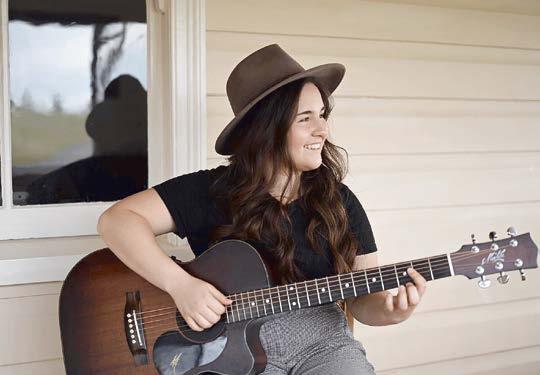
before, but the response was amazing. The vibe was good, and it felt like a shared moment of positivity. This track carries a message of resilience and empowerment. I’m glad the crowd felt that.”
After commencing solo touring in recent
or at felicitydowd.com.au

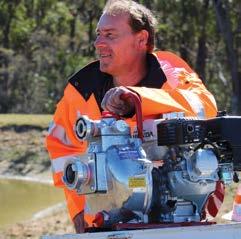
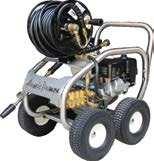
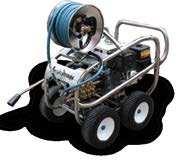





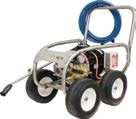



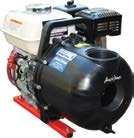

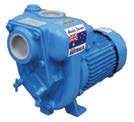

By Fiona Gowers
Country and city reunited once again last month to show their love for the Royal Queensland Show (Ekka).
More than 340,000 people came together over nine days (10 to 18 August) to celebrate agriculture.
The Ekka welcomed 1200 head of cattle to Australia’s biggest beef cattle competitions and hosted the largest showing of stud beef in the southern hemisphere, according to The Royal National Agricultural and Industrial Association of Queensland (RNA).
The association said more than 20 breeds of beef cattle were displayed at Ekka this year.
RNA chief executive Brendan Christou said the support for this year’s show was inspiring as tens of thousands of Queenslanders braved the rain to attend “their” Ekka.
“Rain or shine, Queenslanders came together (over) nine days to celebrate country spirit in the city and support the state’s agricultural sector and farming communities,” Mr Christou said.
“Queenslanders are known for their resilience and I thank them for their wonderful show of support this year. Our competitions showcase the very best of Queensland. Visitors were amazed by award-winning entries and exhibitors in cookery, creative arts, quilt making, blacksmithing, woodchopping, beef cattle, poultry, fleece breeds, canine, cats, horse and showjumping.”
--180,000+ Dagwood Dogs eaten
--142,000+ Strawberry Sundaes eaten
--1500+ Volunteers helped stage the Show
--3500 + Jobs created
--420 exhibitor stands
--32,000+ Cheese toasties (two tonne of butter a and four tonne of cheese)
--180,000+ Schooners of beer
--35,000+ Cans of rum
--5200+ Award-winning steaks
--3.5 Tonnes of fireworks
--32,000 + Glasses of wine
--6000 + Tasting plates of award-winning steak and lamb
--4100m3 + Of sawdust and sand used as animal bedding
--3000 + Corsages made
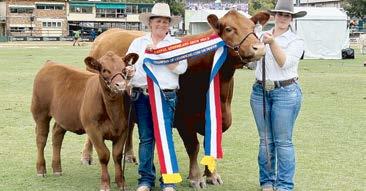
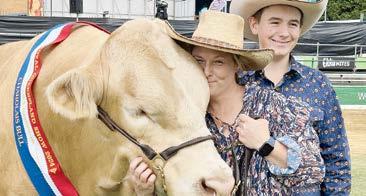

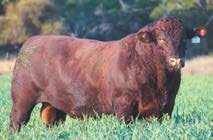

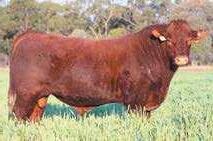
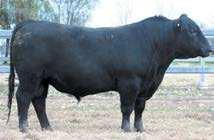
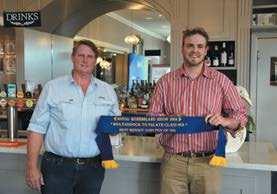
The Morgan family have been breeding Shorthorns in Queensland for over a century and are determined to see The Grove’s influence on the beef industry continue into the future. Along with a strict visual evaluation, the performance recording of large contemporary groups has allowed The Grove to very accurately describe their cattle genetically which means they can breed the desired phenotype with a much higher probability.
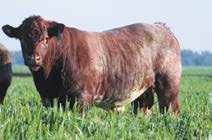

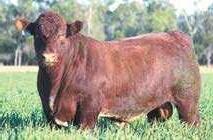



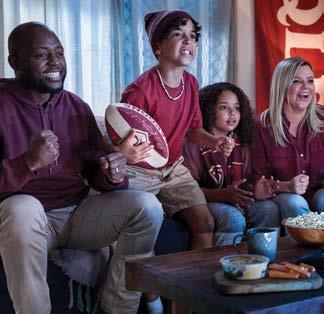




The second of September marks the third annual JAK production sale.
This year we have entrusted the online aspect of our sale to Stocklive and are pleased to announce that our sale will be fully livestreamed with live video footage of each lot as they are offered for your consideration.
Our sale will once again be in the hands of agents Aussie Land and Livestock.
James, Midge and their staff are more than willing to answer any questions you might have or arrange for you to make phone bids should the need arise.
Jambili and Kildare studs are offering 24 South Devon bulls, making this sale Australia’s largest offering of South Devon genetics. Jambili will also offer steers with show ring potential, as well as commercial composite heifers and our popular calf at foot.
One of our features is lot 16 - Kildare Tango. Tango was awarded 2024 Beef Australia and Ekka Grand Champion Bull.
He will be offered as a three quarter share full possession, with Kildare retaining semen rights. He will be collected prior to delivery. At Ekka he weighed in at 887kg and measured 140 EMA.
• Online Sale Catalogue is at: JAK Production Sale 2024 by Five Star Creative Promotions - Issuu
• Online Video Footage of Bulls - To be announced
• Stocklive Link to Sale - Log in will required to bid
• Aussie Land and Livestock - Stud Sales | Aussie Land & Livestock (aussiell.com.au)

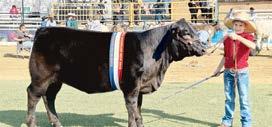




Millie Taylor-Rose, a 14-year-old from Amelia Park, Toowoomba won the Junior and Grand Champion Murray Grey female with Amelia Park Miss Rose.
Millie’s stud was extablished in 2020.
It was her Grandfather David Tayor who won the Grand Champion Male with his only entry Baroona Park Trademark.
He weighed 870 kilograms, with an EMA of 135 square centimetres and rib fat depths of 16 and 13 millimetres.
Kathryn also showed and won Senior Champion Female with Kingsgrove Rose T1.
There are now three generations of Murray Grey breeders in the family.
Baroona Park Murray Grey stud was established in 1985 with foundation females bought at the Warwick Murray Grey stud sale.
In the early days, bulls were sourced from Queensland and New South Wales studs.
Today artificial insemination is used extensively to introduce new bloodlines, as this allows them to match the characteristics of the cows with the bull’s to produce a calf with the desired attributes.
In this way it has been possible to use genetics from leading Australian Murray Grey studs such as Monterey, Woodbourn and Lindsay.
Baroona Park exhibited its first cattle at the 1990 Royal Queensland Show (the Ekka) at which Baroona Park Felicity was awarded Junior Cham-
pion Female.
Felicity’s son Baroona Park Lexington won Senior and Grand Champion Bull at the 1993 Ekka. Since then, we have continued to show stud cattle and steers at local and Royal shows.
“We consider that showing cattle has major advantages for promoting the breed and our stud, as well as providing us the opportunity to compare our cattle with others and to keep up to date with the place of Murray Greys in relation to other breeds,” Baroona Park owner David Taylor said.
“Our daughter Kathryn has been involved with the stud from the beginning and when she returned from working in England in 2006 we transferred one of the good stud females Baroona Park Magnolia to her as the basis of her Kingsgrove stud.
“Magnolia went on to win Senior and Grand Champion Female at the 2007 Ekka and her progeny have formed a solid basis of her stud.”
Fast forward to 2021, when Kathryn’s daughter, Millie, received her foundation female, Baroona Park Millie-Rose, as a Christmas present and Amelia Park Murray Grey stud was established.
To carry on the family tradition, Amelia Park stud won Senior and Grand Champion Female in 2023
2025 will mark 40 years of our family’s involvement with the Murray Grey breed and we are confident that Kathryn and Millie will continue their involvement with the breed into the future.

Midas Gelbvieh has had a great year in the show ring, achieving champions in all categories at Beef 24 and at the Ekka finishing with the double Champion Cow and Champion Bull at Brisbane.
Owner Chris Braithwaite travelled in a group to Canada in late 2023 to observe the Canadian Gelbvieh experience.
He visited a number of renowned Gelbvieh studs and, along with other members of the group, bought genetics through embryos and semen, which will arrive shortly to Australia.
These genetics will give a boost to the Gel-
bvieh industry in Australia.
“I have been breeding Gelbvieh in Australia for more than 30 years and the breed is making solid headway into cross-breeding where the cattle bred are being used in all parts of the industry,” Mr Braithwaite said.
“My breeding program is to breed cattle, not only for the stud but, more importantly, for the commercial producer to fit all areas of the market.
“I have females for sale and bulls ready to go from the paddock to work so please contact me on 0429 073 758.”

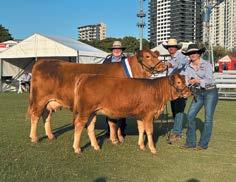
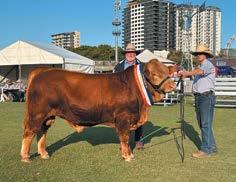

Sunset Park is the first ever Square Meaters breeder to win Grand Champion carcase at the Royal Brisbane Show.
Owned by Julie Gillies, Sunset Park Square Meaters at Crows Nest, Queensland and exhibited and fed by 11-year-old Ella Cannon and her mum Karla, Chelna Square Meaters, Marburg.
Sunset Park steer entry number 219 lightweight led steer carcase winner also placed third on the hoof in the lightweight steer 351-375kg in a huge class of 22 steers.
They also went on to be named the led steer Grand Champion carcase winner from more than 285 entries.
In the 1990s, legendary cattleman Rick Pisaturo developed the Square Meaters breed to address a gap in the market for smaller cut, tender quality, butcher beef.
Specifically bred for the Australian local butcher shop market, it takes just 12 months to produce a dressed body at 200 to 220kg off grass live equals 400 to 450kgs.
Over the years, Square Meaters have done well in carcase competitions Australia-wide.
DeeJay U37 was finished on grain for 60 days, had a live weight of 366kg and dressed at 206.4kg, which equals 56.4 per cent.
His rib and fat at eight and seven and 79sqm eye muscle area.
It’s a fast turn around on investment, according to Lachlan Howland of Golden Pastoral Square Meaters and the vice chairperson of Square Meaters Cattle Association.
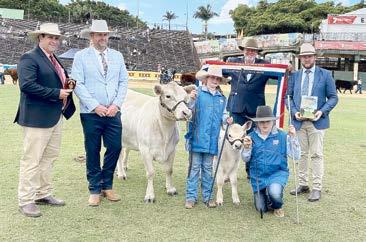
Steer stats for DeeJay U37, DOB 06/09/2023, sired by Vesco Quizmaster dam P22, with Vesco Jack of Diamonds on the dams side. He was bred to meet the Square Meaters strict specifications, with conformation and structure at the top of Julie’s list.
“To say I’m stunned, stoked and speechless is well and truly an understatement,” said Julie Gillies Sunset Park Square Meaters.
“I was literally in the cattle yards at home drafting off steers when I got the phone call. I went from ‘good ol yard language’ to being too stunned to say anything.
“There was no way in a million years I could’ve
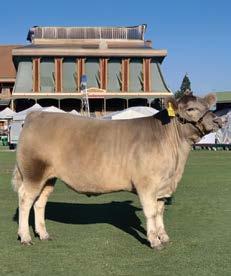
predicted this outcome.
“A huge thanks goes to Vesco Square Meaters and Chelna Square Meaters for annoying me to ‘go find a steer for Ekka’.
“There was no formula. It was a case of wandering up the paddock pointing and going ‘you’ll do’ as steers were ‘light on’ in terms of numbers. You’re bred to do the job.
“Johanna van Elten for her dedication with the

feeding, Karla Cannon for prepping and transporting our entries to get them ‘show seasoned’ Ella Cannon for having the tenacity but also the patience with her animals in the show ring.”
Previous wins for Sunset Park Square Meaters are 2023 first Eating Quality and seconod in class third on hook and third in the Ken McDonald Shield.
In 2022 they won the Ken McDonald Shield.
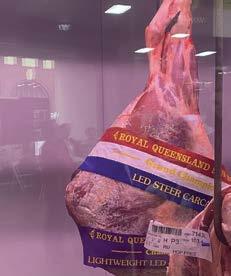

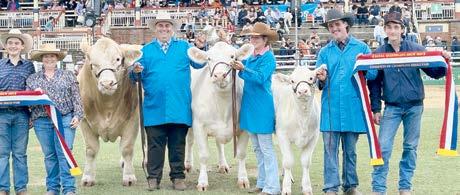

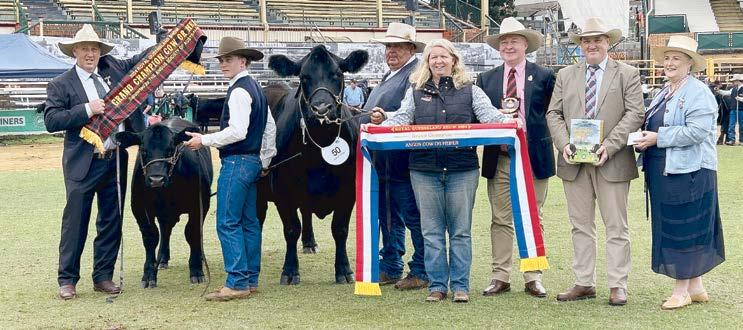
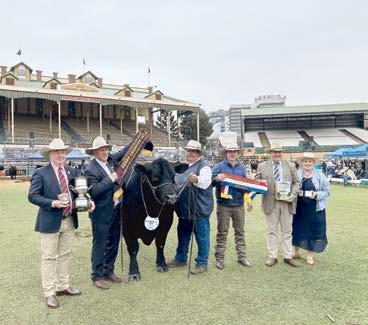
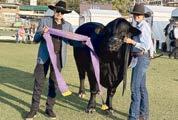

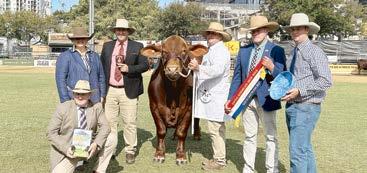

Since the beginning, Huntington’s policy has been to keep pushing and improving the quality and consistency of its seedstock in tireless pursuit of cattle production’s holy grail.
That constant drive for perfect real-world beef genetics has been empowered by the remarkable Charbray breed, and guided by a factual, skin in the game exposure to the real commercial cattle world.
Just as no amount of genius will enable a donkey handler to win a Melbourne Cup, fortune favours only those with the prerequisite fundamentals.
Success then, only requires know-how and unsparing hard work; the Huntington formula is simple: select, improve, repeat.
Family spokesman Matt Welsh talks of the stud’s inventory today as ‘modern Charbrays’.
“The pedigrees we are offering now are gaining outstanding feedback from clients for their consistency, performance and productivity,” he said.
“The prerequisite asset, a union of growth and adaptability, has been improved by decades of exacting development, and is now really paying dividends.
“Our modern Charbrays are pushing new limits in consistency and productivity.”
Matt said these key demands are, effectively, the non-negotiable pre-conditions to success, and the industry today demands high benchmarks in them.
“Huntington remains ever mindful that a benchmark is not a static test,” he said.
“Whether it’s success in the showring or in the saleyards, stud or commercial, you can never rest on your laurels.
“You must keep raising your own standard,
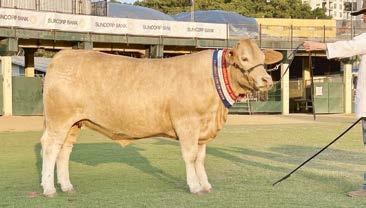
then working towards better outcomes: more calves on the ground to matings; great mothering; faster growth; earlier marketability; and better genetic control, which is consistency.”
Matt said the past is worth remembering but not something to get stuck in.
“For sure, the ups and downs along the way are essential for learning and improving, but at Huntington we are more invested in focusing our energies and programs firmly on the future,” he said.
“That’s what we are excited about: what we are developing in our paddocks today and how we can contribute to a more productive, robust and
profitable future for us and our clients.”
Huntington will offer 50 certified Charbray bulls and a selection of ‘show prospect heifers’ at its annual Spring sale at their on-property Stud Selling Complex, Carrabah Taroom on Friday, October 4.
This follows their successful Brisbane Valley sale of 30 bulls at Toogoolawah Saleyards in August.
The inaugural Huntington Brisbane Valley sale was held last year in response to growing demand for Charbray genetics in the area.
This year’s sale attracted good demand and a full clearance of lots, but just as satisfying accord-

ing to Matt Welsh, was the introduction of new faces in the buying crowd.
“We have a number of repeat buyers in the Brisbane Valley, very successful breeders who we value most highly, and now it is really satisfying and encouraging to see new buyers joining them, being drawn to the Charbray advantages and expanding the herd in the area,” Matt said.
The annual spring bull sale at Taroom is the highlight of the Huntington calendar and Matt said the Welsh family looked forward with delighted anticipation to welcoming buyers old and new to inspect the offering and to catch up for a yarn and refreshments post sale.













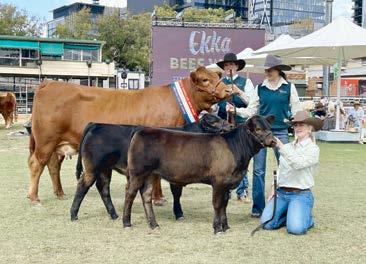

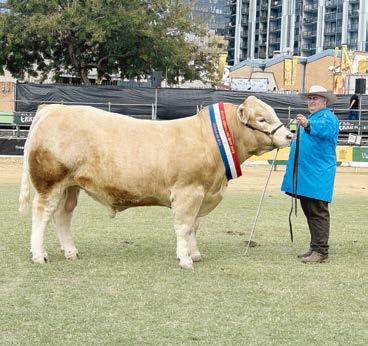
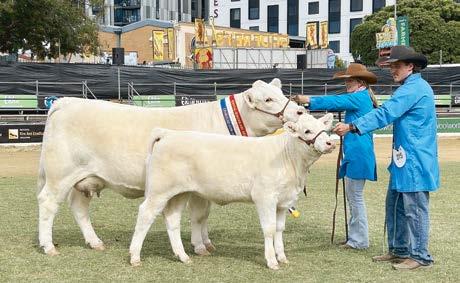
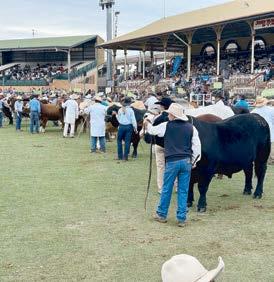
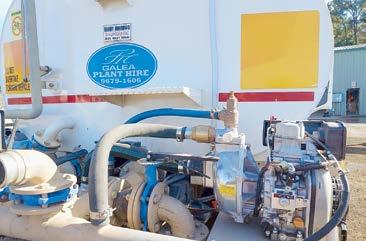


By Helen Mahoney, Aussie Pumps
Improved growing conditions across much of Queensland means agricultural production is expected to rise this year.
The ABARES Agricultural Commodities Report issued in June 2024 predicts Australian farmers will produce $48B of agricultural crops with grains, oilseeds, and pulses contributing $22.6B of that.
The sugarcane production forecast is also up. However, during the harvest the risk of fire is ever-present. It’s important for farmers to plan ahead to counteract the threat of these devastating fires.
It’s a sad fact that every year crops and equipment catch fire while harvesting and farmers should be rightfully concerned.
It’s tragic to run the risk, having worked so hard all year, invested in fertilizer, diesel fuel, equipment maintenance and seed stock, only to see it go up in flames.
Nationwide, fire brigades attend harvest related fires almost every day.
Research shows that fires can be started from a lightning strike, embers from a campfire, a cigarette butt, or even from sparks generated from the Combine itself.
“We heard of a harvest fire started by an overheated bearing on a John Deere harvester,” said Aussie Pumps Regional Manager Dhimant Patel. “An Aussie Pump dealer just happened to be passing when he spotted a fire catching behind the combine! He raised the alarm in time and a water cart was brought in. Luckly the crop and harvester were saved,” said Patel.
Having a water cart or tanker on hand to douse spot fires can be the difference between a minor incident or catastrophic crop and equipment loss.
Aussie Pumps, Australia’s leader in portable fire pump development, has worked with farmers to develop pumps capable of providing real protection. “There is no point in having a 10,000 litre water cart if the pump isn’t powerful enough to use that capacity effectively,” explained Patel.
The company recommends a diesel powered twin impeller pump for the cart because it delivers plenty of water at pressure, and because diesel fuel is safer to handle when there are embers or hot equipment around.
The Aussie Mr T 2” twin impeller pump is regarded by the market as a leader in its class. The Mr T comes with a genuine 10 hp Yanmar electric start, air cooled diesel engine.
The pump is superbly matched with the engine’s capability and is designed to get the most out of both pump and engine.
The Yanmar diesel engine offers loads of torque and allows the pump to deliver up to 90 metres head and a maximum flow up to 450 litres per minute.
The pump is self priming and can draft water from creeks and dams with a suction lift of 7.6m.
The Aussie Mr T is available in either 2” or 3” configuration. Fitted with a 2” outlet it can deliver flows in excess of 200 litres per minute at 75
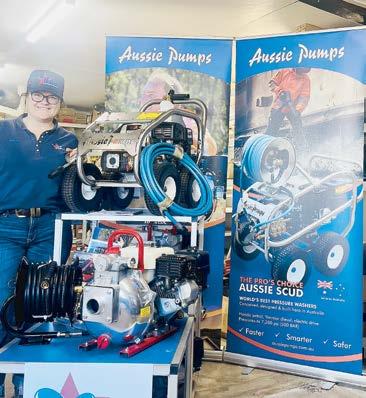
metre head.
In its standard configuration it comes supplied in a robust, galvanised single piece frame. Alternatively, the tanker version of the Mr T is supplied on a stainless steel base plate with antivibration mounts ready for easy installation on the tanker’s platform.
BIG PUMPS DELIVER MORE
For larger applications Aussie Pumps developed its Brigade Boss range of 3” and 4” high pressure pumps that deliver flows of up to 1,250 litres per minute and heads to 70 metres, that’s 100 psi.
Aussie Pumps originally developed these big pumps as village fire protection units but now they are also used for fast filling tankers and for dust suppression.
These pumps are available in both Honda petrol and Yanmar diesel drive configurations and come mounted in robust full frames.
Like all Aussie QP pumps, they are backed up with Aussie’s unique five year pump end warranty with the engine manufacturer’s guarantee covers
the motor.
AUSSIE’S BUSHFIRE SURVIVAL GUIDE … ESSENTIAL READING
Aussie Pumps has again printed huge quantities of their popular Aussie Bushfire Survival Guide to give away free this summer.
It is essential reading for farmers, those living rural communities, and even those on the urban interface who face the challenge of bushfires.
It is a terrific document that shows a wide range of preparations that can be made to minimise the bushfire risk to property and livestock.
It includes pump selection information, how to set up a sprinkler system, and how to maintain your pump in good condition.
More importantly, it empowers those living these vulnerable communities with the information they need to make informed decisions regarding their survival plans.
NEW DEALER ON BOARD
Aussie Pumps is proud to announce that Texas

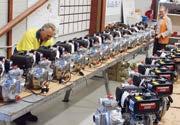
Pumping and Irrigation have been appointed an Aussie Gold Distributor.
They are now stocking and selling Aussie Pump products from their showroom in the High Street.
Mallorie Banks and the team are primed to assist with a range of Aussie fire pumps and professional pressure cleaners.
“We see the partnership with Aussie Pumps as a major step forward in providing quality products to farmers and businesses in the region,” said Ms Banks. “We are seeing a growing demand for quality equipment like the Aussie Pump range. There’s a revolt against third world products that might be cheap, but let you down when the put to any kind of hard use,” she said.
For further information on the Aussie fire pump range contact your local QLD Gold Distributor.
Details can be found on the Aussie Pump website, or call Australian Pump Industries 02 8865 3500. aussiepumps.com.au
From page 30
Sherry said they ended up planting around the post so that they get the nutrients they need.
“It’s all drip irrigation throughout the property from the dam.
“We were trying to mulch once a year and feed the plants minerals as needed. The mulches include wood-chip or sugarcane, together with biochar to put carbon back into the soil - that increases the micro-biology as well.’’
Bruce and Sherry are growing a few different varieties but mainly commercial reds, a red flesh variety - and some megalanthus. These are the yellow ones with white flesh and lemonade flavour.
The yellow dragonfruit are the rarest seen in Australia - and the Ningana fruit took out first place this year at the Gympie Show.
The curiosity about dragonfruit is that in many shops they are not labelled red or white flesh.
“You might be able to see it on the box that they are delivered in,’’ Bruce said.
“They make an amazing dessert - this brilliant red with ice cream. It just looks great.’’
The fruit is high in fibre and antioxidants, Sherry said.
“It’s a very refreshing fruit because of the moisture content. It must be served chilled.
“There are a few other varieties we’ve been experimenting with as well.
“They taste something like a kiwi fruit with a pear texture.’’
Sherry picks a red fruit from a vine and explains how it is starting to blush.
“You can see the red tinge.
“We need to pick it before the birds get into them. Just store it a little bit more on the bench and then pop it in the fridge.’’
To harvest the fruit, Bruce and Sherry use special cutters - not secateurs but precision pruners that are sharp on the end. This is so that you’re cutting a bit of the vine as well, otherwise the spikes on the plant will damage your arms.
Each of the little nodes forming on the vine will form a fruit but not all in the one season. They can self-regulate and limit the amount of fruit they bear.
Bruce and Sherry have been at Bells Bridge 15 years and planted the dragonfruit four-to-five years ago.
“We originally fenced to graze sheep and have done a lot to improve the soil,’’ Sherry said.
“It has been forest soil. We put a lot of effort into the microbiology by increasing plant matter. Bruce makes all the biochar on the farm.’’
Biochar is the carbon and ash remaining after the heating of biomass, and is a form of charcoal.
For Bruce, the biochar is like a little hotel for microbes.
“Each canal in that biochar is an opportunity for microbes to lodge in there. It’s protection for them.’’
There have been lessons learned along the journey of growing dragonfruit - and surprises too.
“We know they don’t like long periods of cold weather,’’ Bruce said. “There was some die-back a couple of years ago from that.
“It was a wet winter.’’
Among the surprises have been finding that when the plant is stressed from hot, dry weather they tend to produce more fruit.
“A few years ago we had a long stretch of dry weather and they produced well, but the past couple of years there’s been more rain.
“Three years ago, we had the best yield. That year we were picking 500 fruit every second day.
“The more consistent rain the vines get, the more growth.’’
There is nothing more satisfying than to go for wonder of a nice afternoon and pick a few crates of dragonfruit, Bruce said.
The vines have a queen-of-the-night style flower, Sherry added.
“It comes out for one night, usually on a full moon, and 35 days later we have a fruit to pick.
“This was always our retirement plan, to get this orchard up and going - they don’t take much to care for and they’ll be here for decades.
“For us, that was the appeal. We can slowly grow the orchard as a farm together.
“It’s not intense labour for us. The kids like to get amongst it as well.’’
The dragonfruit do suffer at times with insect damage from the heliothis moth.
“The caterpillar will tunnel its way into the fruit,’’ Bruce said, “so we’ve had some losses with that.
“We don’t use chemicals - if we have a few loss-


“This
was always our retirement plan, to get this orchard up and going - they don’t take much to care for and they’ll be here for decades. For us, that was the appeal. We can slowly grow the orchard as a farm together.”
es it’s just nature’s way.’’
Bruce and Sherry’s philosophy is that everything stays on the farm.
“The pig loves the fruit,’’ Sherry said, “so nothing goes to waste.
“The pig takes care of everything.’’
For Bruce, he didn’t plan on growing dragonfruit as their main form of income.
“I’ve always wanted to do it but was just going to establish it and see how we went.
“It was going to be an interest rather than my income.’’
Bruce grew up in The Dawn area, while Sherry is originally from Imbil.
A Valentine’s Day train trip to Kandanga for lunch on the original Mary Valley Heritage Railway highlighted their love of the region and, while they didn’t realise it then, this affinity with trains would lead to Sherry’s career move with the Mary Valley Rattler instead of as a physical education (PE) teacher.
Bruce started as an apprentice at Madills Motors in Gympie, and over the past 25 years moved into trucks and tractors, semi-trailers and motorcycles.
“I’ve got a bit of a broad farm basis of knowledge, so when I started my own mobile mechanical business I could take on most things.’’
For Sherry, endurance riding adds to achieving a perfect work-life balance.
Having started riding while at primary school, she joined the Imbil Forest Endurance Club.
Her first Australian Endurance Riders Association (AERA) ride was in 1999. That was at Rosedale where she won the junior section of the 80km event.
More recently Sherry won line honours and first middleweight in the 80km event at EnduraFest, held at Inglewood.
“That has been my greatest sporting career highlight … together with achieving a buckle for completion of the 160km course at the 2022 Tom Quilty Gold Cup at Tooraweenah in New South Wales.
“This for me is, if you talk about work-life balance, gives me that. Some have a gym membership, others go on a park run, or spend time with friends.
“With endurance riding it’s something you can share with family and friends.
“Endurance is a family sport. To complete is to win … but it’s more about the horse’s journey than mine.
“It’s about putting extra work into this horse - to grow him. The state championships are at Widgee later this month and I have set my sights on that. After all, it’s right in our back yard.’’
This balancing of life with work through having the farm is important because they are both so busy.
“It’s good to be busy,’’ Bruce said. “The farm is central for our work.
“When we bought the property we wanted to be far out of town enough to get a substantial amount of land that we could actually utilise.
“It was a bit tricky in the beginning to find some land flat enough, yet with some water and within our budget - we ended up putting some roots down here.’’
This was bare land, Sherry said, and there is still some remnant vegetation.
“So everything you see here is how we built it up ourselves - the house, the sheds and the fencing.
“That’s been very rewarding.
“We wanted something to grow among gum trees and there are not many orchards you can do that with.
“We thought we’d give it a go and it’s actually worked out.
“These plants are tolerant of shade - they don’t mind it. The foliage can get burnt in the heat of summer whereas having some vines among the trees get that afternoon shade and only a few hours of intensive sunlight.
“They do better as they’re a rainforest jungle plant from Central and South America.
“They are a canopy plant so they’re heading for the light. In the wild they climb up a host tree.
“It’s almost companion planting.’’
Initially the plan was to have the sheep graze among the vines to keep the grass down but they started nipping the buds off the vines.
Now it’s a matter of whipper-snippering among the rows.
As for the sheep, there are about a dozen dorpers in the flock.
“You get the stocky body weight from the dorset and the grazing type habit from the black Persian,’’ Sherry said.
“We even had a baby lamb this morning.’’
As we make our way up to the shade tunnel Sherry said they have had coriander and radish growing for market and Brisbane restaurants.
But this season it’s mainly just stuff for the home, such as planting some tomatoes for a winter crop - without the insects of summer.
The wicking beds comprise of gravel on agricultural pipe, then geo mesh and soil on top. Water is fed into the base so soil will not get stodgy.
“They are good for us in any inclement weather,’’ Sherry said. “When it gets really dry, we are not relying on the sub-soil to provide the moisture. We can mediate that.
“The best part is you get straight carrots, celery, radishes … the root crops do really well.
“It’s always good to find a market before you put stuff in the ground.’’
There are so many advantages of this style of farming, Bruce said.
“You cannot have it on a broad scale but having the crops in the tunnel, it is a controlled environment.’’
Up at the farm stall, Sherry explains how collecting honey was a natural step for her.
“Obviously the bees play their part, being dotted around the farm. They pollinate the plants and take some back to the hive.
“They create that really healthy ecology.
“Here on the farm we have something to eat and something to sell.
“Without bees, we don’t have life. We are so luckytobeabletosharewhatnaturehasprovided.’’
Sherry’s initial interest came from father-in-law Henry and brother-in-law Andy.
“They are right into bees. Andy has Holistic Hives.
“I got interested in bees and the benefits of hav-
ing them.
“It started with a Flow Hive six or seven years ago and then one went to two. Now I have a bunch in the front garden and also down near the dragonfruit.’’
Selling it in squeeze bottles means there is no need to scoop the honey out of a jar with a metal spoon.
“There’s not a distinctive taste to the honey, but there will be dragonfruit as well as the eucalypt trees,’’ Sherry said. “The native wattle is out of the moment.’’
“You tell the difference between whether the bees have obtained the pollen from the gum blossoms or the wattle.’’
For Bruce, an important aspect of growing something on your property is about teaching the next generation that they can provide for themselves and others in the community.
Meanwhile Sherry enjoys the selling and swapping of produce.
“We have the farm shop where people can stop and take the opportunity to get fresh dragonfruit or honey right from the farm gate - with no extra handling, no middle man.
“They can get it as fresh as it can be … that’s fulfilling for us. It’s significantly cheaper than commercial supermarkets.
“That money can go back into the farm and the fruit.’’
Something Bruce is proud of is the role they play in promoting the region - no matter how big or small.
“If someone is going for a day trip out to the Bunyas or whatever, they can stop off at farm shops on the way.
“There are people always stopping in. A lady gets our fruit for making ice cream and there are others who take it to market.
“It’s not high in sugar, so people with blood sugar issues can enjoy it.
“I’ve seen a dragonfruit sorbet at Sunshine Plaza - a beautiful iridescent pink dragonfruit sorbet with lychee.’’
Dragonfruit are good in smoothies and yoghurt, Sherry said, because of the colour and nutritional value.
“At the heart of it,’’ Bruce said, “is the fact you are producing something of value, something you can share, something that has goodness in it.
“You know where it’s come from - off your own property. And you get a lot of satisfaction from that, knowing you can play a part in your community, with your neighbours and people in your area.
“You become known as the bee man, the dragonfruit man or the mandarin man … it comes back to not having to do everything, but if you can do something well, then you can exchange that and everyone is a winner.
“You don’t have to be self-sufficient but you can play a part in making the region self-sufficient.
“Everyone is going to have their niche product. Not everyone can be expected to have everything.’’ There’s a lesson here for us all. As many people learned during the pandemic, it can be incredibly rewarding to grow your own produce and know the origin and history of your food. Bruce and Sherry are chasing their dream, and in doing so have brought a nutritious product to their local market that others can enjoy.
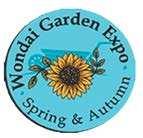
WondaiSportsgroundandLionsPavilion,BunyaHighway,Wondai. Saturday8am–4:30pm.Sunday8am–1pm.
Admission:$5.00perdayor$8.00fora2daypass.Kidsunder15free. Concessionforgroupsof10ormore,$4.00perpersonpre-paid.


FreeParking.Disabledparking.Busdropoffandparking.Freeplanttransportand cloakroomforeasycollection.ATMonsite.NODOGSplease.TICKETSareatthegate. CASHONLY.
GuestSpeakersincludeLawrieGreenwhowillbetalkingabouthowtodivideandrepotOrchids. WewillalsohaveRayRallingswhowillbegivingusallthetipsandtricksanhowtogrowandcarefor AfricanViolets.WarrenRufiusfromWormFarmOasiswillexplainwhyallhealthygardeningstartsin thesoilandwhywormsarenatureslittlegems.ThenJoyPatchwilldelightuswithhervastknowledgeon howtodivideandrepotdayliliesandothercottagegardenflowers.
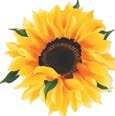

We’llalsohaveHelenYoungtalkingabouthowtogrow,divideandpropagatethebeautifulandhardyBromeliads.
Qualitystallswithahugevarietycoveringallthingsgardeningincludingplants,fertilisers,pots,ornaments, gardenart,tools,specialtyplants,locallymadehoney,wineandsomuchmore.Fullycateredwithplentyof foodanddrinkstallsandcoveredseatingareas.
WondaiDistrictGardenClubHorticulturalShowandHangingBasketcompetition OfficialopeningisSaturday10:30amandGuestSpeakersstartat9am.








uson
Secretary:JodiBiltoft0413115495
Email:info@wondaigardenexpo.com
applicationsinfo:www.wondaigardenexpo.com
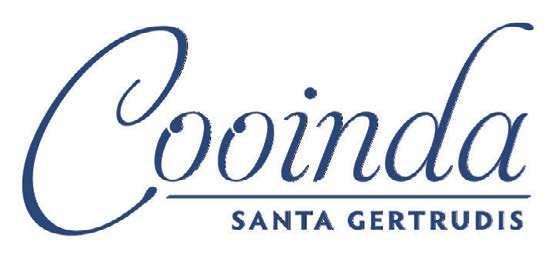




Report Date: 21/08/2024
Saleyard: Dalby
The number of cattle penned at Dalby increased by 1,330 head to 5,251 following the rain reduced yarding the previous week. Export buyer attendance was good with strong support from southern operators plus the return of one major Queensland processor. The regular feed and trade buyers and restockers were also present and active in the market.
The recent falls of rain lifted restocker enthusiasm and light weight yearling steers returning to the paddock averaged 17c/kg better and light weight yearling heifers lifted in price by 9c/kg. Medium and heavy weight yearling steers to feed sold to strong demand. Medium weight yearling heifers to feed from the north-west of the state lifted average prices by 17c/kg. Heavy weight yearling heifers to feed averaged 10c/kg less. Heavy weight cows averaged 7c/kg cheaper.
Light weight yearling steers returning to the paddock made to a top of 442c with a good sample at 393c/kg. Medium and heavy weight yearling steers to feed made to 399c with most sales from 376c to 380c/kg. Light weight yearling heifers returning to the paddock made to 342c to average 302c/kg. Yearling heifers to feed for the domestic market averaged from 321c to 331c with isolated sales to 370c/kg. Heavy weight yearling heifers to feed made to 341c to average 319c/kg.
Heavy grown steers to export processors made to 350c and the bullock portion 345c to average 340c/kg. Medium weight 2 score cows averaged 247c/kg. Heavy weight 3 score cows averaged 280c and the best of the cows averaged 303c with some from the north-west of the state making to 312c/kg. Heavy weight bulls made to 304c/kg. Trevor Hess Market Reporter, Report Date: 08/08/2024
Saleyard: Emerald
The yarding at Emerald sale increased by 229 head to 1224. Cattle were drawn from the local area and north to Clermont and Collinsville. The major portion of the yarding comprised grown cattle for processors and feeders with very few restocker lines. A reduced panel of buyers lead to an easing of prices for most descriptions.
The few yearling steers sold to 335c/kg. Yearling heifers went to restockers and processors for the veal trade to average 169c to 231c/kg.
Grown steers made to 315c/kg with the best of the trade heifers selling to 270c/kg to average 255c to 262c/kg for the best presented pens.
Heavy, four score cows reached a top of 252c/ kg to average 240c/kg to processors. Heavy bulls sold to 235c/kg to record averages of 215c/kg . Richard Thomson, Reporter
Report Date: 20/08/2024
Saleyard: Roma
With increased numbers Roma Agents Yarded 6459 head. All the regular processors feedlotters and backgrounders present. Once again a mixed quality yarding penned including weaners heavy


feeders accredited grain bullocks and crop finished cows.
Light weight yearling steers under 200kg topped 420c/kg. Yearling steers 200 to 280kg with the majority selling from 320c to 418c/kg. Yearling steers 280 to 330kg improved by almost 25c/kg and topped 438c/kg. Yearling steers 330 to 400kg also improved and sold to 416c/kg. Yearling steers 400 to 480kg sold from 314c to 398c/ kg for the better quality lines. Yearling steers over 480kg also in demand and sold to 386c/kg.
Light weight yearling heifers under 200kg sold from 200c to 338c/kg. Yearling heifers 200 to 280kg also sold to stronger trend and made to 360c/kg. Yearling heifers 280 to 330kg could not maintain the price increase as other categories but sold to 368c/kg. Yearling heifers 330 to 400kg topped 370c to average 344c/kg. Yearling heifers 400 to 480kg also the 480kg plus sold to 352c/kg.
Grown steers over 500kg sold to 388c/kg to feed. The over 600kg bullock selling to processors at 328c/kg. Certified grain bullocks sold to 340c/ kg. Bullocks over 750kg sold to 290c/kg. Grown heifers over 540kg made from 260c to 328c/kg. Just under 1000 cows penned including crop fattened heavy cows. The 2 score cows made from 200c to 264c/kg. The 3 score cows topping 312c to average 303c/kg. The best of the heavy weight bulls sold to 285c/kg.
David Friend, Market Reporter
Report Date: 20/08/2024
Saleyard: Warwick
The return to fine weather saw agents at Warwick pen 1,244 cattle. The overall quality and finish of the cattle improved which resulted in prices lifting across the restocker and feeder yearling steers and heifers plus all export classes. All the regular buyers attended and operated.
Yearling steers in the 200-280kg range to restockers made 406c to average 371c/kg. Yearling steers over 280kg to background sold to 396c and averaged 386c/kg. Yearling steers to feed for the domestic market made 402c to average 373c/kg. Heavy yearling steers to feed sold from 373c to 377c and averaged from 360c to 375c/kg. Light weight yearling heifers to background sold to 394c and averaged 304c/kg. Yearling heifers over 280kg to feed made 349c to average 315c/kg. Heavy yearling heifers to feed made 340c to average 321c with those to the wholesale meat trade topping at 394c/kg.
Grown steers to feed made 371c to average 341c/kg. Bullocks to processors sold from 349c to 355c and averaged from 332c to 339c/kg. Grown heifers to feed made 346c to average 314c/kg. Light weight score 2 cows to processors made 265c to average 230c/kg. Score 2 heavy cows to processors sold from 235c to 245c with the good heavy cows topping at 300c to average from 272c to 290c/kg. Heavy bulls to processors made 318c to average 291c/kg.

Errol Luck Market Reporter
Sheep Report Date: 20/08/2024
Saleyard: Warwick
Agents at Warwick penned 1,748 mixed quality sheep and lambs. All the regular buyers attended however one processor did not operate. Lambs to suit the wholesale meat trade improved in price from $11 to $19/head with store lambs to restockers also lifting by $3 to $5/head. All the mutton penned sold to very strong competition resulting in prices remaining firm.
Light weight young lambs to restockers sold from $56 to $68 with the crossbred selling from $62 to $81/head. Young lambs over 18kg to processors sold from $71 to $86 with those to feed at $80 to $110/head. Lambs in the 18-20kg range to feed sold from $103 to $130/head. Light trade lambs sold from $147 to $200/head. Lambs in the 24-26kg range to the wholesale meat trade sold from $168 to $212 with the heavy lambs topping at $220/head.
Light weight hoggets to processors sold from $90 to $126 with the heavy hoggets at $110 to $141 and the crossbreds topping at $168/head. Light weight ewes to processors sold from $51 to $67/ head. A line of 216 crossbred ewes with 40 lambs to restockers sold to $81/head. Heavy ewes to processors sold from$80 to $110/head. Wethers sold from $70 to $90/head. Rams to processors sold from $55 to $80/head.
Errol Luck Market Reporter







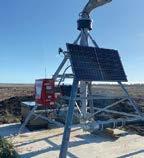



Broadacre Irrigation with it’s knowledge and expertise are an industry leader in the design and use of Centre Pivot, Lateral Move Irrigation Systems, and Solar Pumping Systems based in Goondiwindi, Qld. Broadacre Irrigation is the dealer for Lindsay Manufacturing "Zimmatic" centre pivots and lateral move irrigators in the Northern NSW and Southern and Central QLD regions.
As a leader in the field Broadacre Irrigation has been able to help many clients to increase irrigation efficiency and lower running costs with better design, management and innovative ideas. Recent jobs have been in the Emerald and Rollstone Area.
Broadacre Irrigation is fully integrated with its own staff from the design, installation, service and maintenance. Broadacre Irrigation has a fully stocked warehouse in Goondiwindi, enabling us to supply many machine parts straight from stock or with direct import to site. This also means no delays in supplying spare parts.
Phone or Email Broadacre Irrigation for a no-obligation quote for all your Centre Pivot, Solar Pumping, Stock Water, Poly Welding and all irrigation needs.

Phone: (07) 4671 0235
Mobile: 0437 456 628
Email: sales1@broadacreirrigation.com.au www.broadacreirrigation.com.au
Wilson

















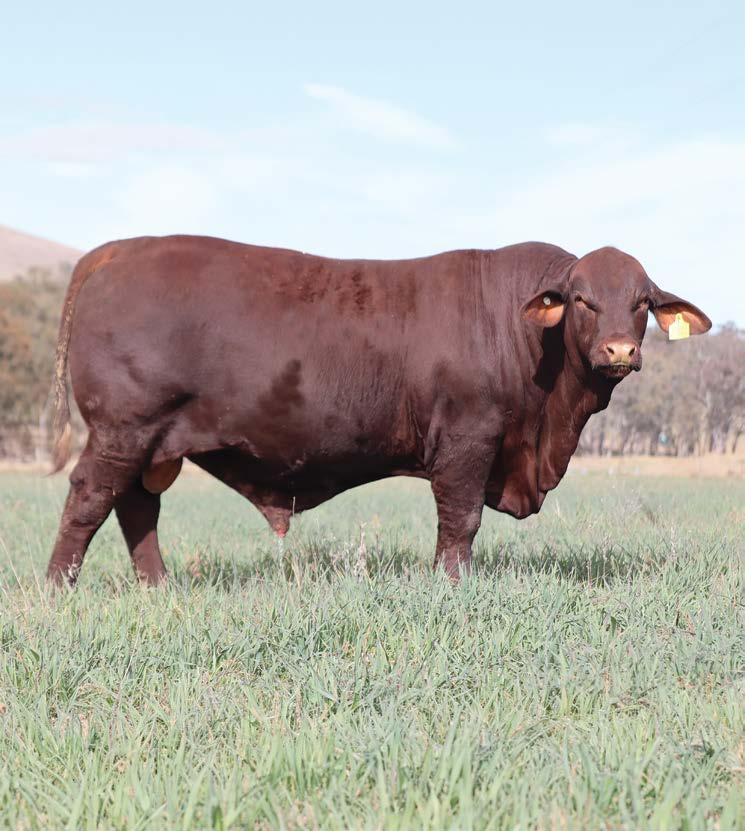
By Fiona Gowers
Australia’s largest beef processor JBS recently hosted a carcase competition at its Townsville plant where North Queensland producers were given the chance to enter cattle for expert analysis and benchmark against others.
Taking inspiration from other industry carcase competitions, this is the third year the JBS Townsville plant has hosted the carcase competition.
JBS Townsville livestock manager Simon Fraser initiated the event after identifying the opportunity to profile and celebrate grass-fed cattle that thrive throughout regional Queensland.
Over the past three years the number of entries into the competition has increased, with more than 20 vendors submitting livestock this year.
The competition provides producers the opportunity to take a tour through the JBS Townsville processing plant and follow the supply chain through to end product.
Alongside the carcase competition, a blind tasting of six different breeds from the competition were tested and judged by attendees. Brangus was crowned the champion breed based on flavour, texture, taste, appearance and overall liking.
JBS Townsville livestock manager Simon Fraser congratulates all competition entrants on their fantastic achievements.
“In its third year, our carcase competition is great to highlight the exceptional quality coming out of North Queensland and the continued commitment our valued producer partners have to building consistent herds that tick all the boxes,” Simon said.
With five classes to enter, the judges commemorated the cohort of high-quality entries making the difference between placegetters marginal.
Winners of each class are as follows:
Class 1
On Hoof Pen of Three
• First: G and C Connolly
• Second: AJ and CM Bethel
• Third: Broadford Pastoral
Class 2
On Hook Carcase Pen of Three – HGP Treated
• First: B and B Shephard
• Second: S and T Trust
• Third: G and C Connolly
Class 3
On Hook Carcase Pen of Three – HGP Free
• First: Lisgar Pastoral
• Second: EE Cox
• Third: Koolyn Pty Ltd
Class 4
Highest MSA Index Individual Carcase
• Champion: Broadford Pastoral
• Reserve Champion: AJ and CM Bethel
Exhibitor
• Champion: Lisgar Pastoral
• Reserve Champion: EE Cox.



